64 Rustic Farmhouse Aesthetic Ideas for a Cozy and Timeless Home
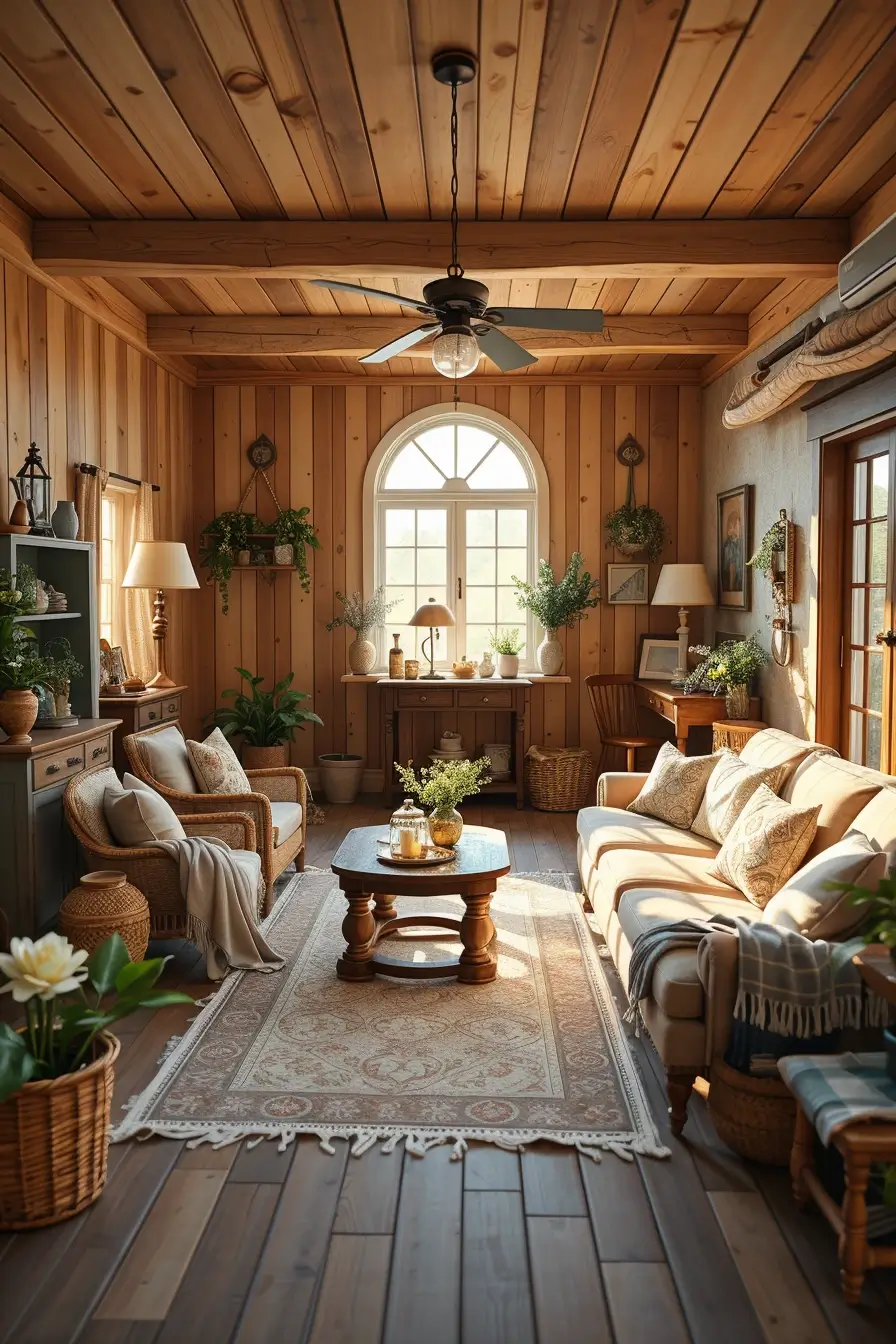
The rustic farmhouse style has turned out to be one of the most popular interior design styles among those who like the feeling of warmth, simplicity, and natural beauty. So how do we adapt this old time appeal and apply it to the modern house? In this post, I will discuss some of the best design solutions, key furniture items, and styling tips that will allow you to create the most appropriate farmhouse look. If you are looking to decorate a big house or a small apartment or just want to add some cozy farmhouse touches to the one you have, you will find inspiration here.
By combining the old and the new, such as natural wood, reclaimed furniture, and vintage-inspired accents with more modern elements, rustic farmhouse style produces a classic yet practical living space. How to incorporate modern touches, make the most of small spaces, decorate on a budget, and, most importantly, love the timeless appeal of farmhouse style.
Introduction To The Rustic Farmhouse Aesthetic
The rustic farmhouse style is all about the warm wood textures, warm interiors, and timeless furniture choices that are both comfortable and characterful. So, what is so attractive about this style and why has it become one of the most popular design approaches in a modern home? These are the questions that I would like to answer in this article based on my own design experience.
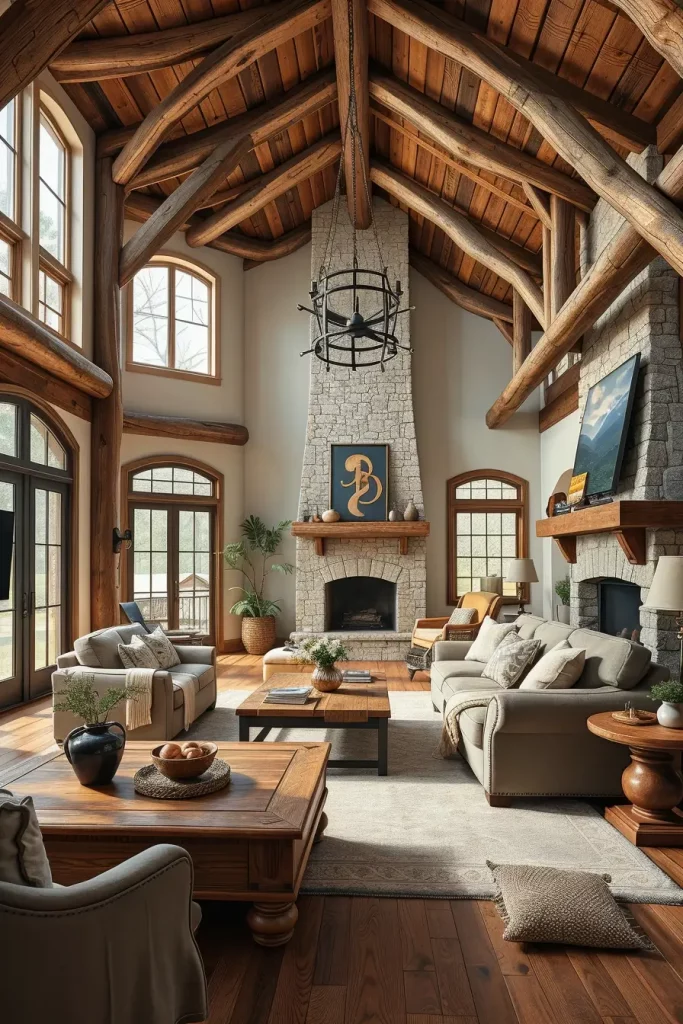
I have experienced this aesthetic in my work, and how it balances the old-world and the modern practicality. The natural materials, neutral tones, and well-chosen furniture make the space warm and practical. Be it the exposed beams in the living room or old dining tables, these add character to the house.
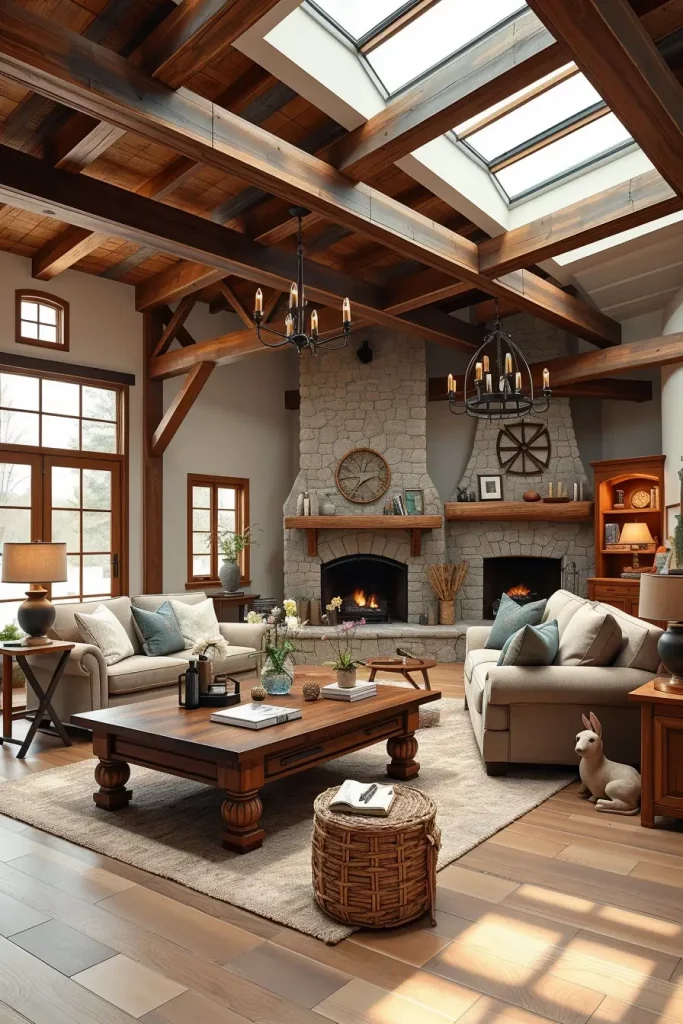
I suppose the reason why this style is so attractive to many homeowners is that it is adaptable. It is equally effective in a country cottage and in a modern suburban home. The farmhouse style enables you to be creative and at the same time make the home friendly to family and friends.
Origins Of The Rustic Farmhouse Style
The rustic farmhouse style has its roots in the traditional rural life, where the functionality was the main design principle. Simple yet functional, early farmhouses in America and Europe were made of what was available, wood, stone, and handmade furniture. This historical background still affects our perception of the style to this day.
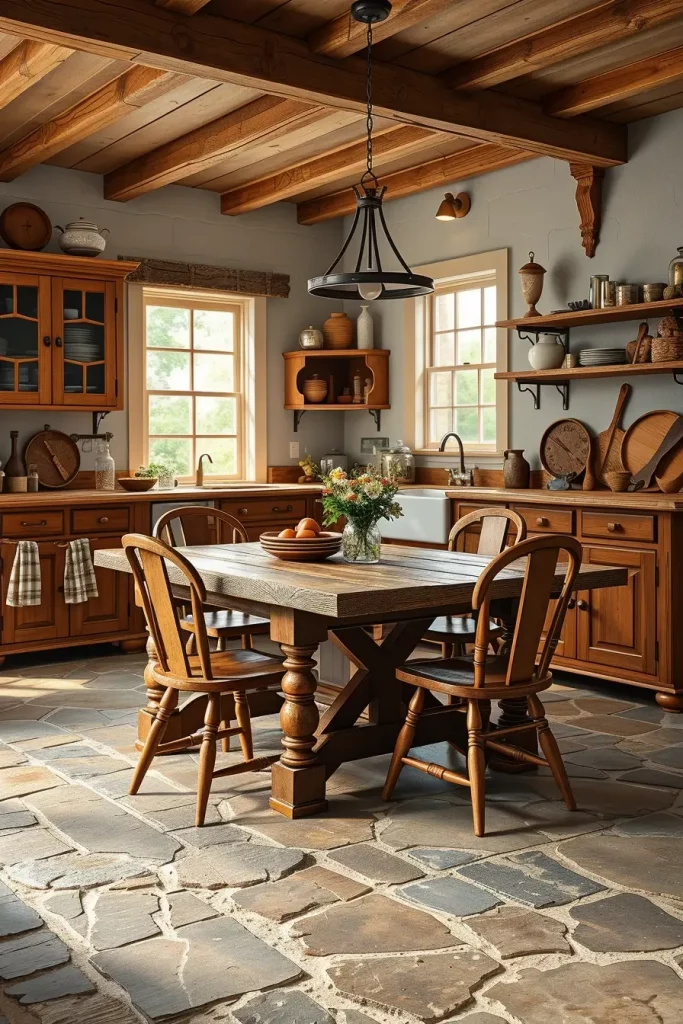
When I look at farmhouse interiors, I observe such items as long harvest tables, simple chairs, and handmade cabinets that used to be everyday necessities. These items were not created to be decorative, but were made to be durable and were frequently handed down through the generations. They continue to be the mainstay of farmhouse decor.

To my mind, the most important lesson of these origins is authenticity. Professional designers such as Joanna Gaines have stressed that farmhouse interiors work best when they are rooted in their history, with an appreciation of natural flaws, reclaimed wood, and functional design taking precedence over over-designed ideas.
To complete this section I would also propose to add some actual references to farmhouse life by using heirloom pieces or antiques. A small inherited chest or an original farmhouse door used in a new design automatically adds depth to authenticity
Defining Features Of Rustic Farmhouse Interiors
When I talk about rustic farmhouse interiors, I always have to begin with the fact that they are warm, textured, and full of lived-in comfort. These rooms are deliberately layered, with nothing prominent over the rest. Exposed wood, neutral colors, and vintage elements are in harmony.

I have used reclaimed wood floors, stone fireplaces and white shiplap walls heavily in my projects to create the tone. I prefer big, comfortable pieces of furniture such as overstuffed sofas or farmhouse tables, to ground the room. Lighting fixtures, usually lantern-style or wrought iron, contribute to the general atmosphere.
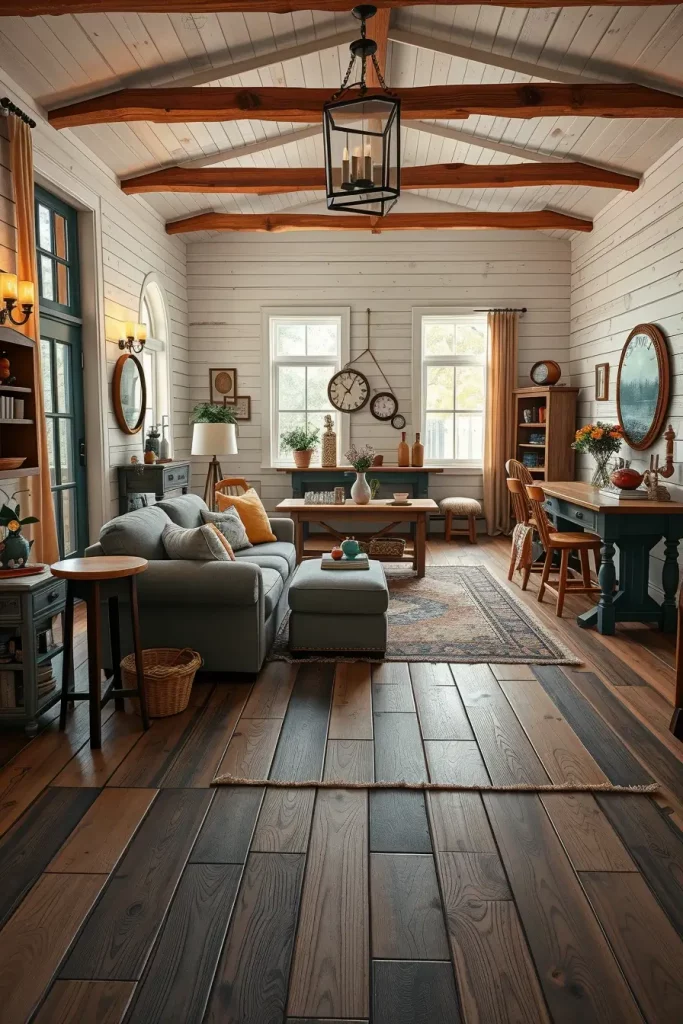
In my opinion, the flexibility of this design is one of the best things about it. Better Homes & Gardens says that farmhouse interiors are most successful when they strike a balance between functionality and coziness- too refined and they lose their appeal, too cluttered and they lose their comfort. It is all about the sweet spot.
I believe that this style is completed by adding handcrafted accessories, such as woven baskets, pottery, or vintage rugs. These are the final touches that can make a place feel natural as opposed to artificial
Natural Materials That Create Warmth
The farmhouse style focuses on natural materials. Wood, stone, linen and metal combine to form a warm and welcoming atmosphere. I have always viewed these as a means of anchoring the house to the surrounding.

In practice, I usually suggest hardwood floors, rough-hewn beams, stone backsplashes, cotton or linen fabrics as curtains and upholstery. Even wrought-iron handles or brass accents are simple and provide depth and texture.
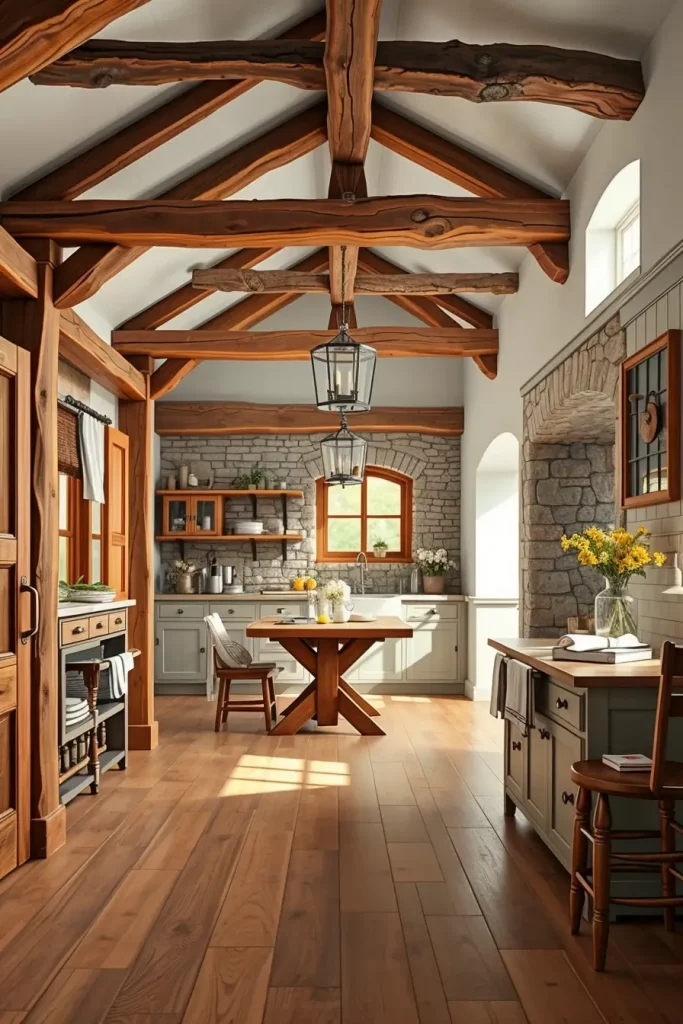
Homeowners who value these materials most appreciate their classic nature. They become more beautiful with age and can be modified to meet the changing trends in design without losing their rustic look. Most professionals at Architectural Digest tend to agree that natural materials are the best investment in terms of long-term value.
I would also recommend the inclusion of sustainable features here, such as reclaimed wood or salvaged brick, which not only fit the style but are sustainable choices as well.
Wood Beams And Exposed Ceilings For Character
Among the most prominent features in the farmhouse interior is the use of wood beams and the exposed ceiling. I adore how they immediately add depth and personality to a space, and can be the focal point.
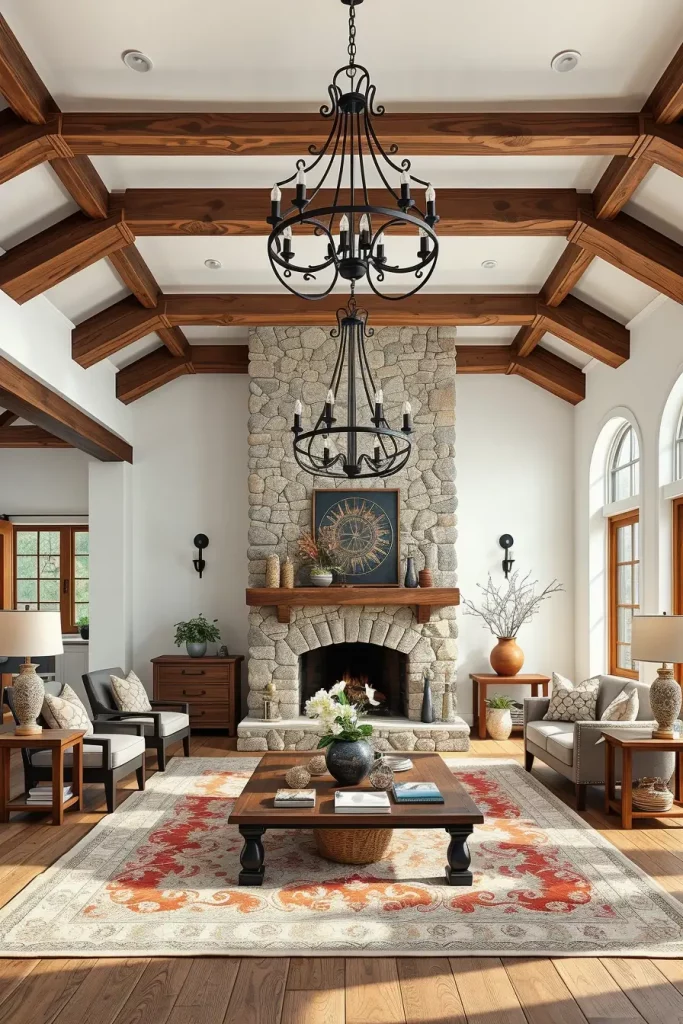
In rooms I have been in, white-painted walls and stone fireplaces go well with the exposed beams. They also provide the opportunity to be creative with lighting- a wrought-iron chandelier or pendant fixtures between beams.
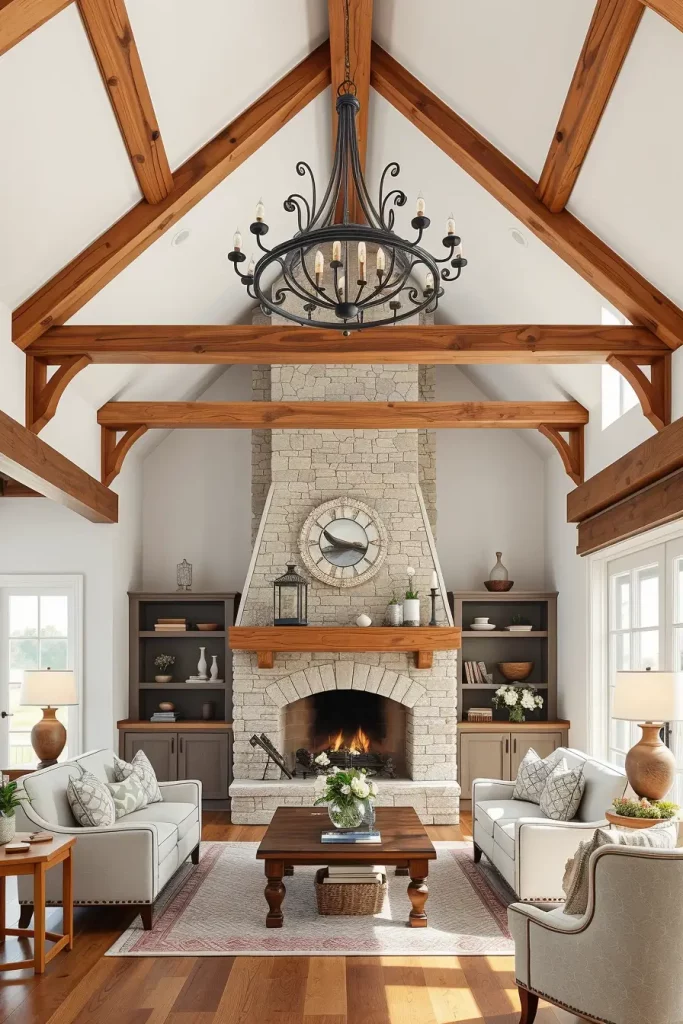
To me, the perfection is in imperfection. Even with knots and cracks, natural wood is a story. It relates us to the art of the past generations. US-based designers such as Studio McGee have emphasized the need to embrace raw textures in the modern farmhouse.
To reinforce this part, I would recommend adding variations, e.g. reclaimed barn beams or painted beams, depending on the style of the home. It is an aspect that should not be ignored.
Stone And Brick Accents For Farmhouse Charm
Stone or brick instantly adds to the farmhouse look These materials can be used to create a fireplace, an accent wall, or a kitchen backsplash, etc. I regard them as the structural soul of the home.

In interior design, I always suggest using stone fireplace in the living room and brick walls in the kitchen or dining area. These characteristics go hand in hand with wood floors and neutral color schemes. They are daring and classic.
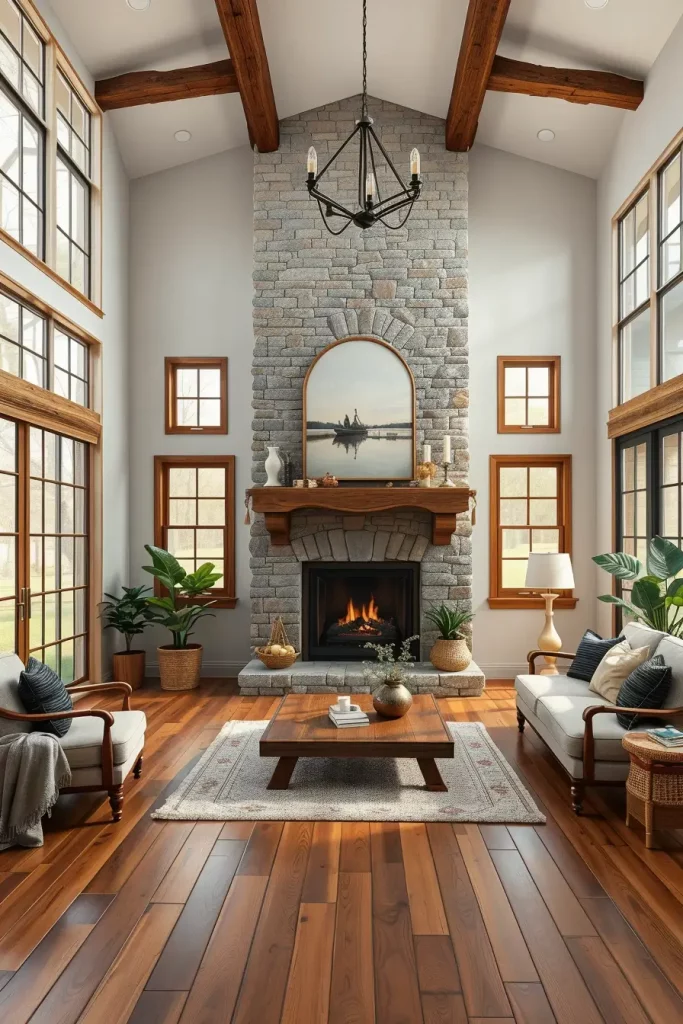
I think the reason why stone and brick are so attractive is the tactile aspect of it. They crack up flat surfaces and give depth. Magazines such as House Beautiful are quick to note that these materials can be used to strike the right balance between modern and farmhouse design.
I would recommend adding stone or brick to outdoor patios or entryways to give the look a continuous flow to the outside.
Rustic Farmhouse Color Palette Ideas
The color scheme of the rustic farmhouse is usually neutral and soft, and the textures and natural materials are in the spotlight. I have always been drawn to whites, beiges, warm grays, and earthy browns with this style.

I also tend to use creamy whites and contrast them with darker accents such as charcoal gray or black hardware. Muted blues and soft sage greens are also a great choice of color in a farmhouse kitchen or bedroom.
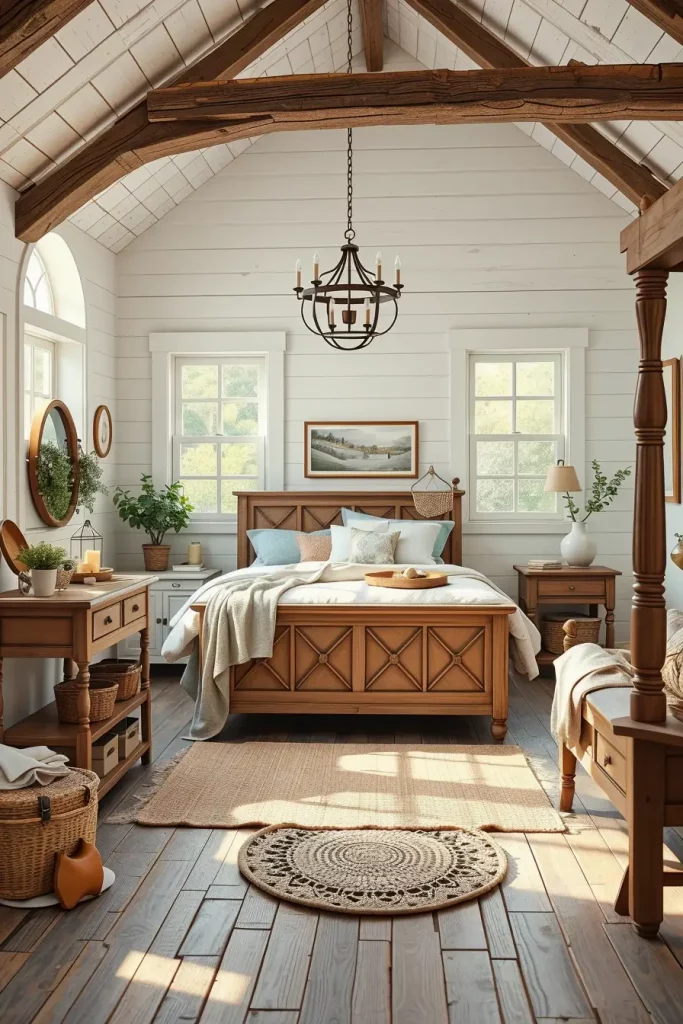
I would recommend not to use too bright or unnatural tones. The aim is to make something harmonious, not distracting. According to Real Simple, neutrals and earth tones are calming and flexible, so it is easy to layer furniture and decor without a clash.
To take this palette to the next level, I would recommend introducing natural textures such as a sisal rug or woven wall decor that would ground the color scheme to the texture of the room.
Choosing Furniture With Rustic Farmhouse Appeal
When I take homeowners through the process of selecting farmhouse furniture, I always insist on practicality and comfort. This style is most effective when furniture is solid, dependable and classic. Wooden tables, sofas, and simple cabinets are the main features of the style which make the everyday life easier.
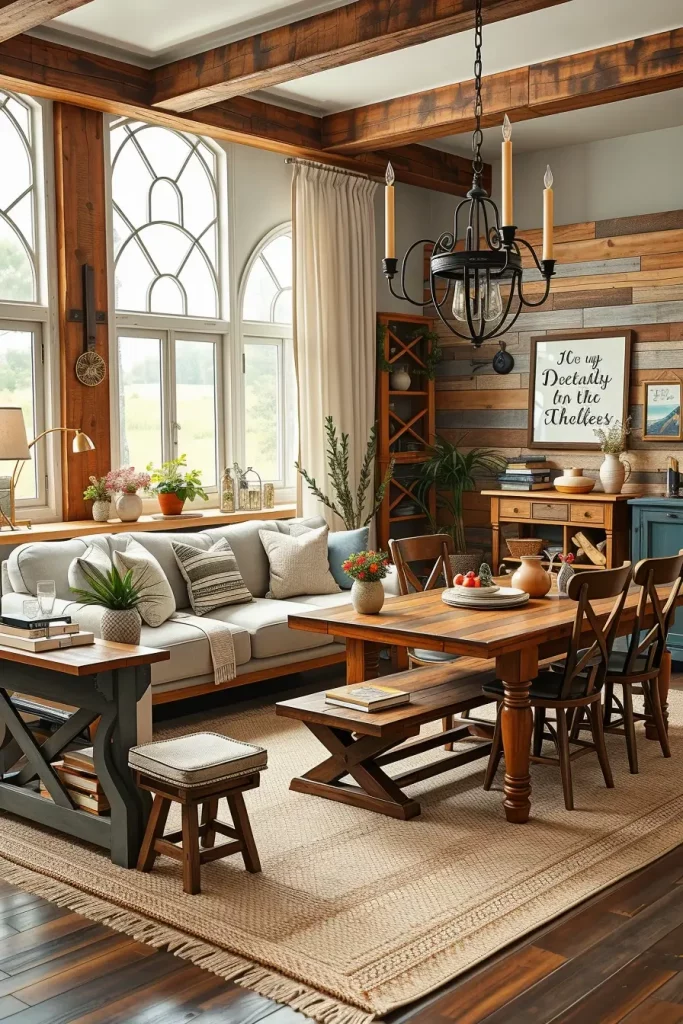
In my personal work, I have incorporated over-sized sectionals in linen slipcovers, reclaimed wood dining tables, and vintage ladder-back chairs. These items are solid and can be used on a daily basis and still have that rustic appeal.
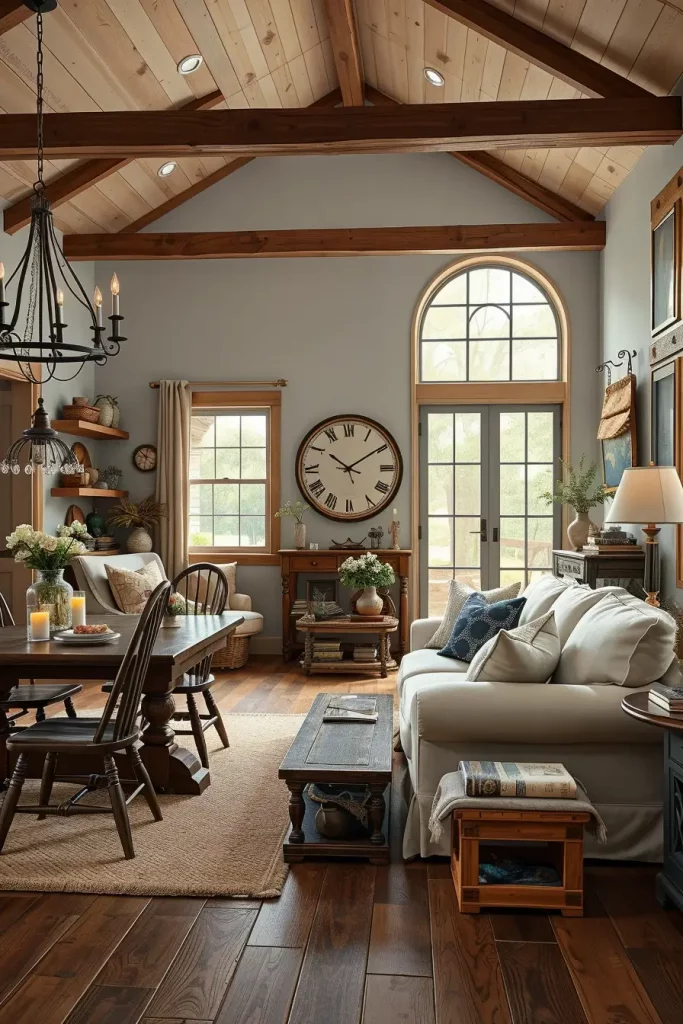
To me, the farmhouse furniture is not about fancy design but comfort that is lived in. Better Homes & Gardens has also advised purchasing quality well-made items as opposed to trendy ones, as they will stand the test of time and age better.
I would also recommend using multifunctional furniture, such as storage benches or vintage-finished cabinets. Such additions are a balance of beauty and utility that is the core of the rustic farmhouse style.
Vintage And Repurposed Furniture Inspirations
I also like the fact that with this aesthetic, it is possible to use old furniture or repurposed objects. These add a sense of reality to the room and usually become a topic of discussion. Each scar or patina has a story to tell.

In farmhouse style, I have repurposed old chests as coffee tables, old dressers as bathroom vanities and old trunks as storage. These re-purposed items bring in more history and yet they blend in perfectly with contemporary homes.
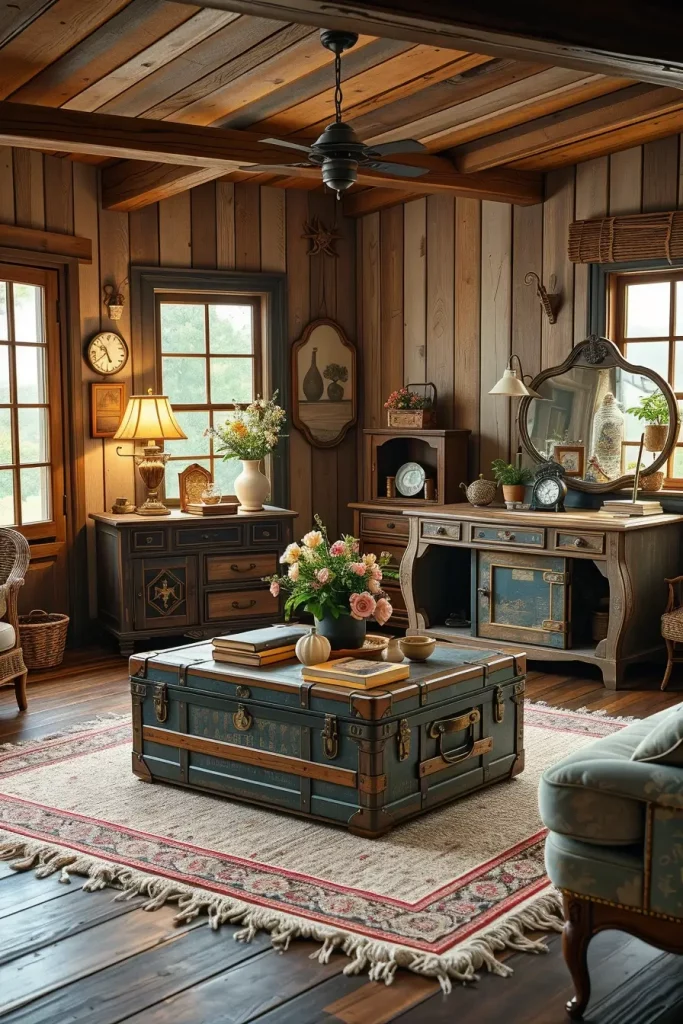
I personally believe that a combination of old and new makes the space fresh. Designers such as Emily Henderson often mention the need to balance this, too much vintage can make a room feel cluttered, but a few well-chosen pieces can bring the design to the next level.
I would suggest going to flea markets or antique stores to purchase inexpensive, but distinctive furniture. Just one piece of outstanding vintage can change the character of a room.
Cozy Farmhouse Living Room Concepts
The living room on the farmhouse must be the center of the house. To me, this implies creating a place where comfort and togetherness are the priorities. The soft seating, layered fabrics, and warm light are a must.
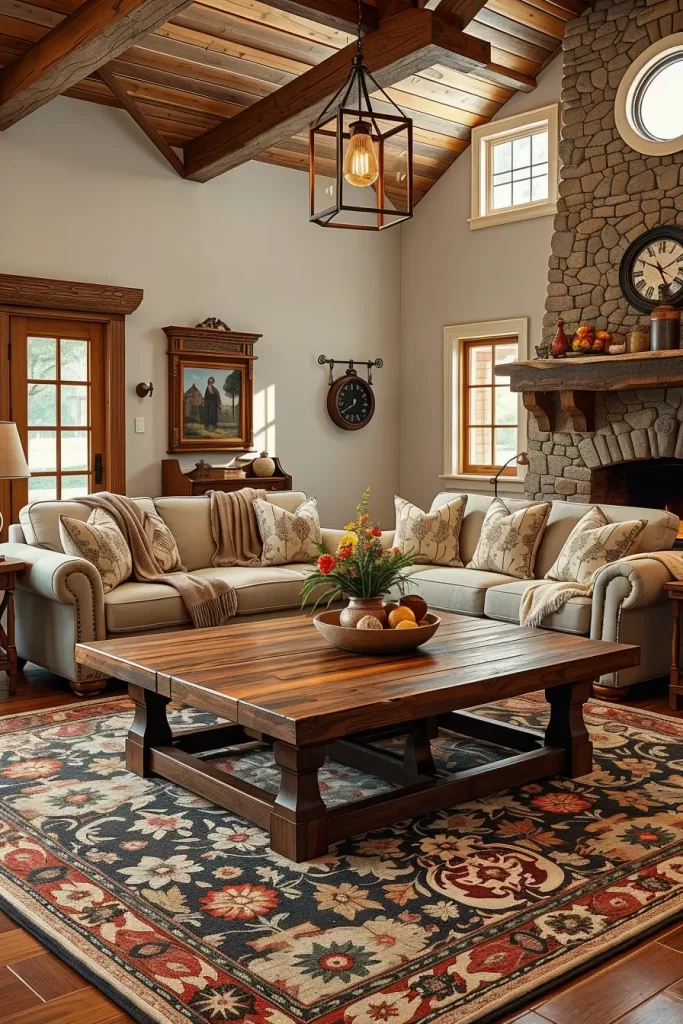
I tend to suggest a neutral sofa with some cozy throws, a coffee table made of reclaimed wood, and a large area rug with minor patterns. A fireplace, where possible, is the centre of attention, particularly when combined with stone or brick.
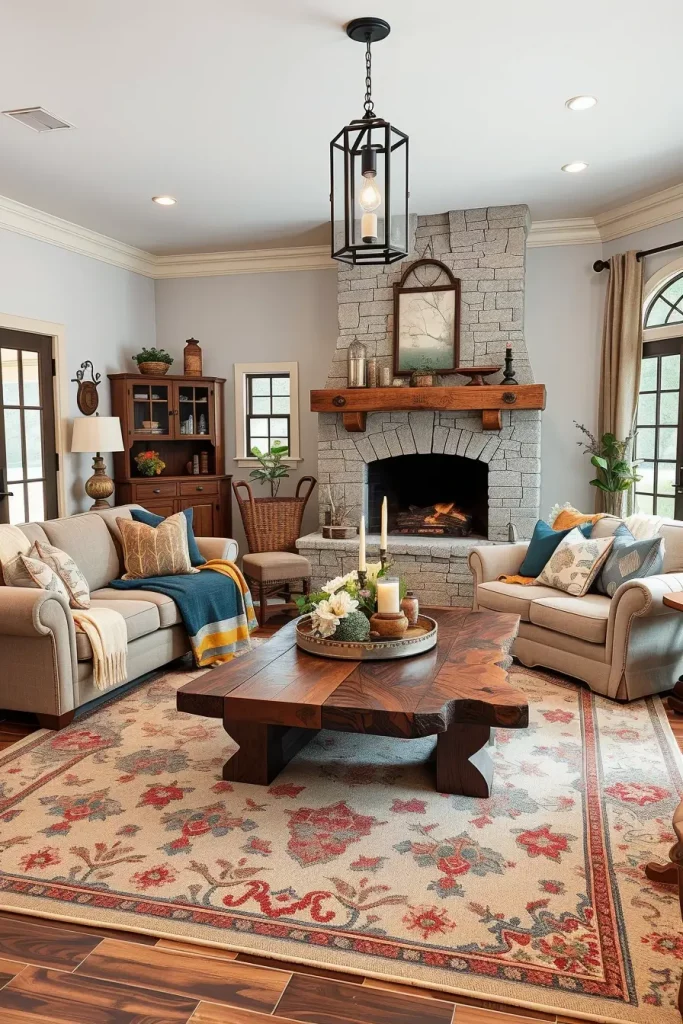
I think that lighting is one of the best options to fill the space. Country Living says lantern-style lights or rustic floor lamps are functional and charming. I also prefer to include built-in shelving with carefully selected decor to make it more personal.
What I would include here is greenery, simple potted plants or fresh flowers to give freshness to the room. Even some natural accents will make the space seem more welcoming
Farmhouse Kitchen Design With Rustic Accents
The kitchen in the farmhouse is usually the most vivid place in the house. I think it is a combination of functionality and beauty, where family and friends are drawn to. Wide countertops, open shelving, and apron-front sinks are trademarks.

In kitchens that I have designed, I have incorporated reclaimed wood islands, shaker-style cabinets and open shelving with dishes organized neatly. I tend to pair these with subway tile backsplashes and vintage-style lighting to keep the design timeless.
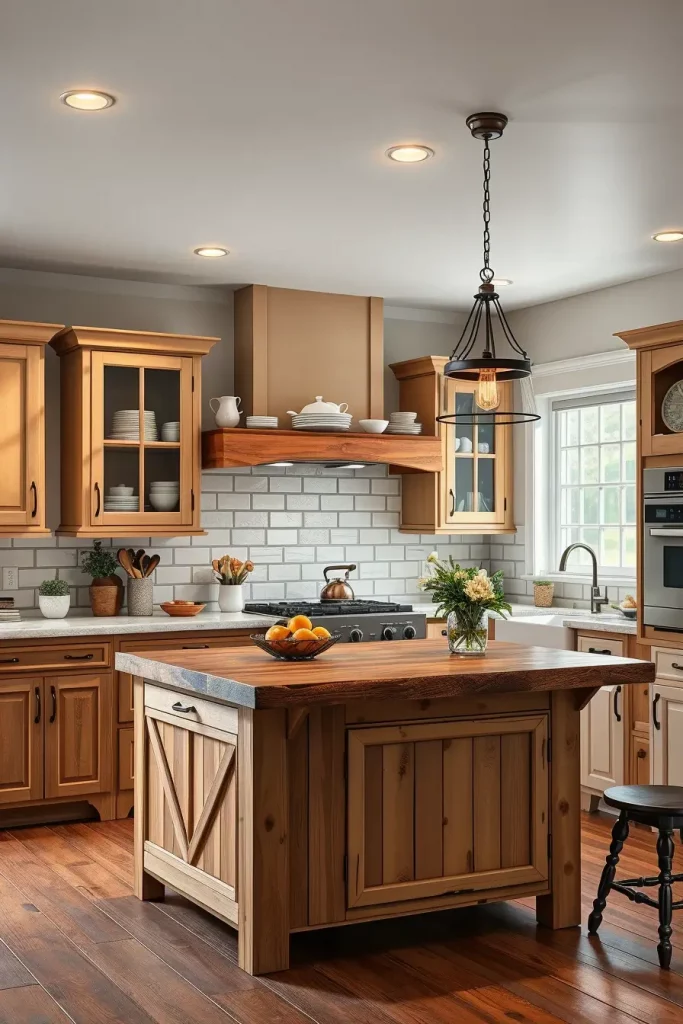
In my opinion, the kitchen must be practical and personal. Designers frequently comment in Architectural Digest that open shelving is best styled, so that it is not too cluttered, but just enough to give it a lived-in feel.
I would also recommend that you incorporate some modern elements into the rustic structure like stainless steel appliances. This makes the kitchen as efficient as it is attractive to look at.
Warm And Inviting Farmhouse Dining Spaces
I always aim to design a warm communal space when I design farmhouse dining rooms. Wooden tables, a variety of seating, and dim lights transform the usual meals into memorable events.
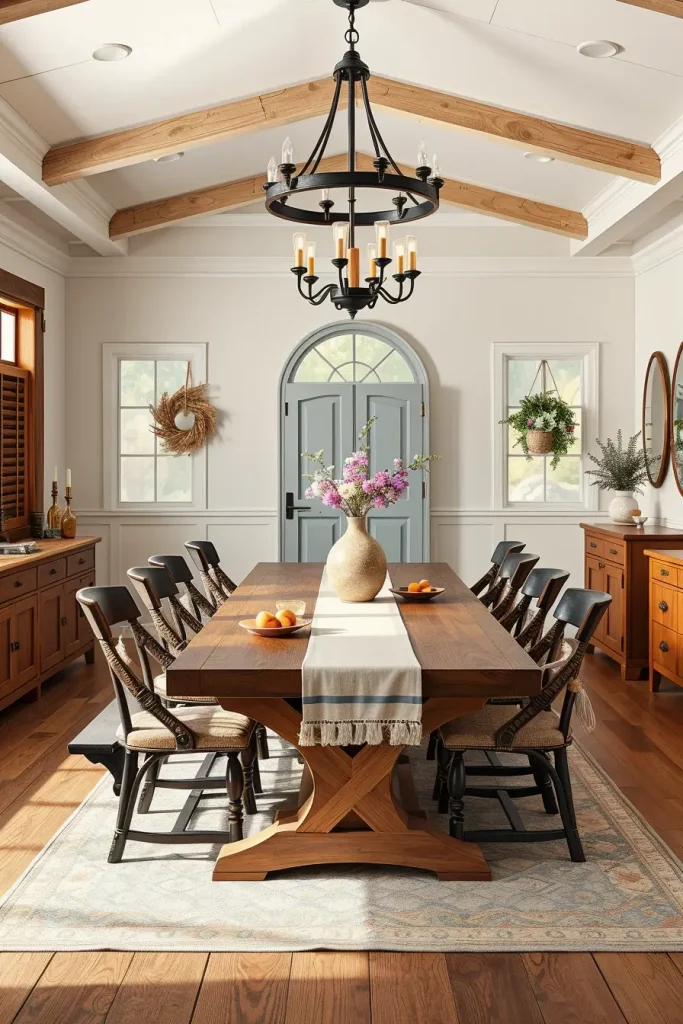
I tend to suggest trestle tables with a combination of bench and chair seats. The ends of the table are furnished with upholstered chairs that make it comfortable, and the rustic chandeliers above the table create the atmosphere.
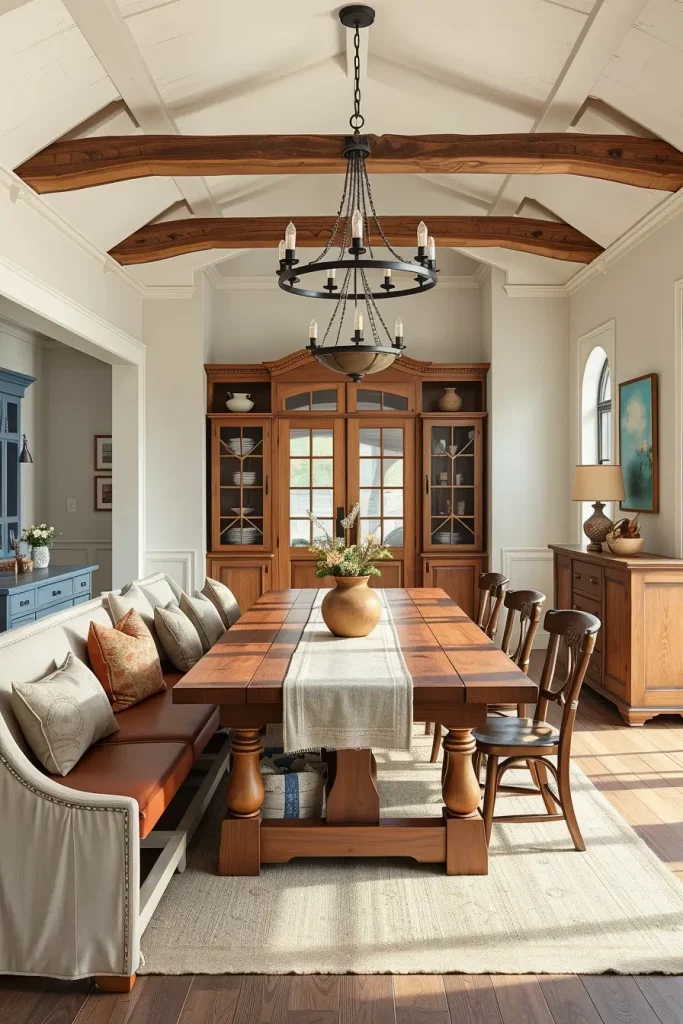
I think that less decoration is better to show the furniture. House Beautiful often notes that the best farmhouse dining rooms are those that are kept uncluttered, so that the table is the focus. A simple centerpiece such as a ceramic vase with seasonal flowers is also beautiful.
What I would add to this would be textures, such as linen table runners, woven placemats, or handcrafted pottery that would bring the design together without making it too busy.
Bedroom Retreats With Rustic Farmhouse Touches
The bedroom in the farmhouse is a retreat and rest bedroom. I always make these spaces calm, using soft colors and textural materials to make it comfortable.
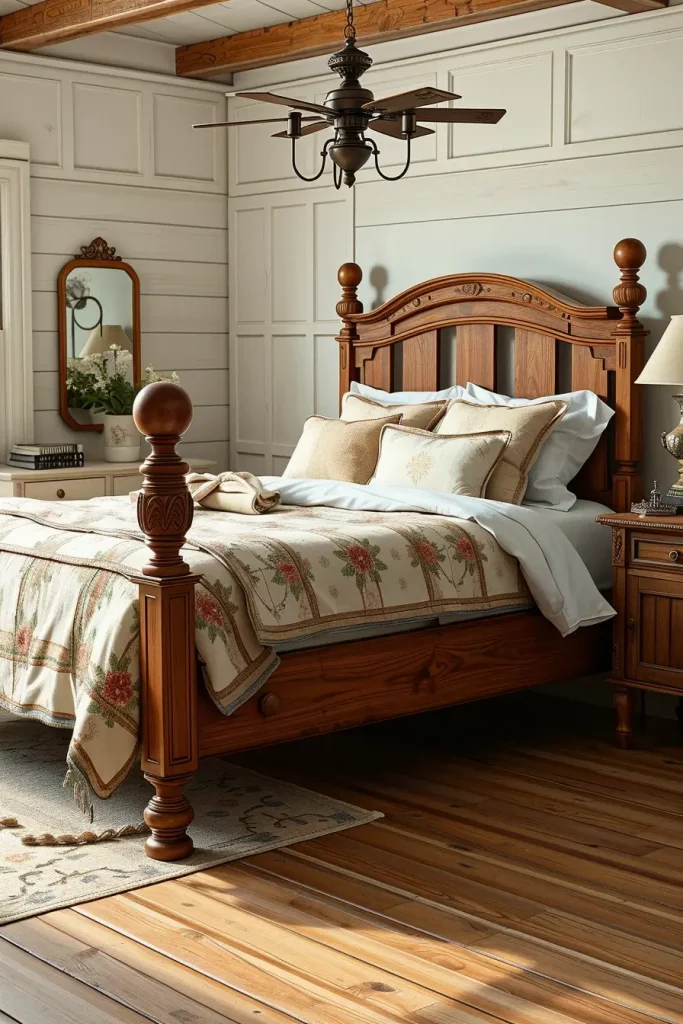
I tend to use wooden bed frames, plain bedding in cotton or linen, and antique nightstands. Wrought-iron bed frames are also a nice touch, and layered quilts on the bed reinforce the farmhouse style.

In my opinion, bedrooms are best simple. The gray color combined with textured fabrics creates a calm effect that makes the room conducive to sleep, as Real Simple observes.
I would also recommend a bench at the end of the bed or a reclaimed wood dresser. The space is beautiful and practical due to these details.
Bathrooms Styled With Rustic Elegance
Even bathrooms can be touched with the rustic farmhouse style with grace. I perceive them as a possibility to mix natural textures with modern fixtures, and create a warm and functional retreat.
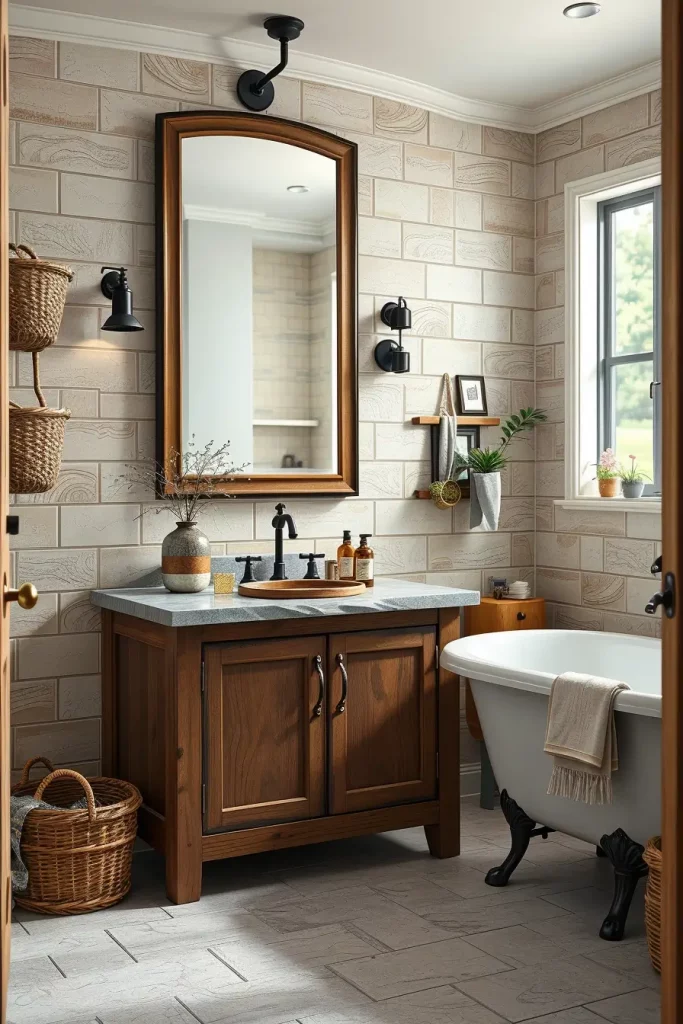
In my projects, I have incorporated wood vanities and stone countertops, subway tile walls, and vintage-style mirrors. Clawfoot tubs or apron-front sinks are a farmhouse touch that keeps the room classic.
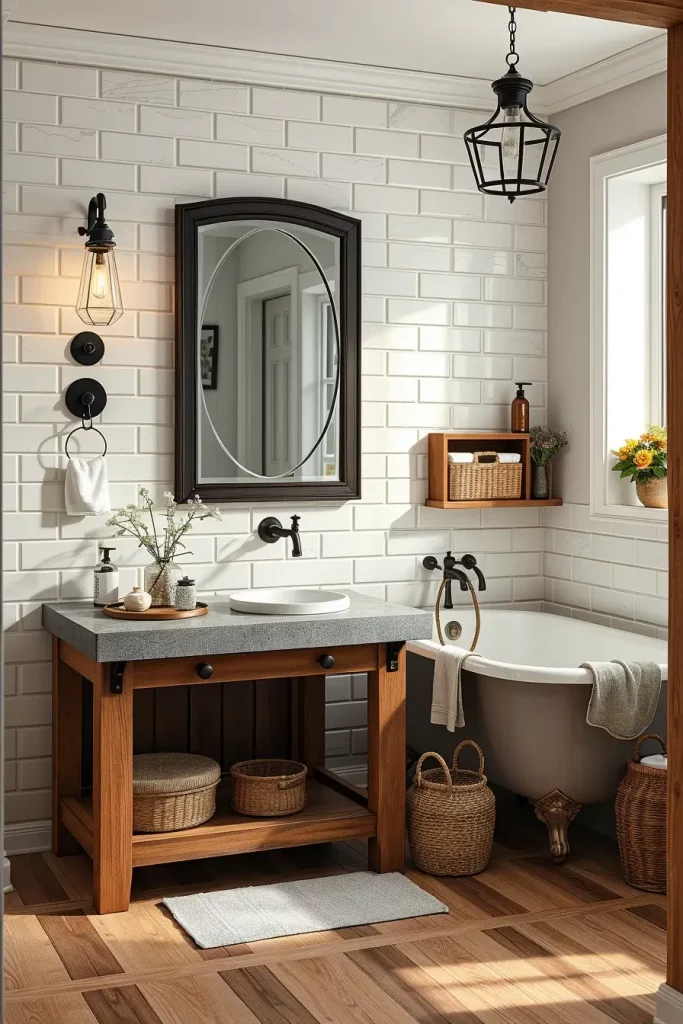
I am personally a fan of mixing finishes in these bathrooms, such as matte black fixtures and brass accents. Elle Decor also reports that mixing metals is one of the biggest trends that can make even rustic designs look elegant.
To reinforce this appearance, I would also suggest soft light, like wall sconces or lantern-style lights, to keep the warmth. The woven baskets or reclaimed wood shelves add more texture and functionality.
Farmhouse Entryway Ideas That Welcome Guests
The first impression that I am after, when I am designing a farmhouse entryway, is a warm one. The entryway will establish the mood of the entire house so the reclaimed wood benches, weathered hooks to hang coats, and woven baskets to store items will make it practical yet beautiful. A carefully designed entrance area with rustic furnishings does not only provide functionality but also brings in the natural materials that are the key to farmhouse style.
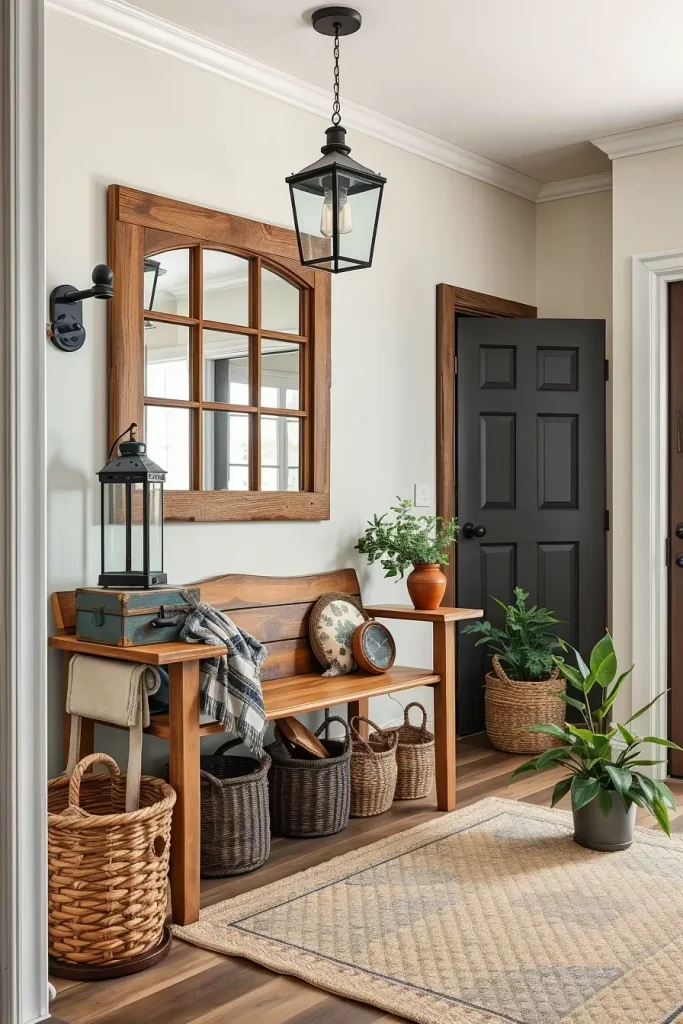
In this kind of design, I would suggest a strong wooden bench, a rustic console table and galvanized metal items such as umbrella stands. A huge farmhouse mirror in a reclaimed wood frame brings depth and light to the room, and lantern-style lighting provides a warm atmosphere. These pieces blend to create a balance between comfort and rustic beauty.

In my personal opinion, a farmhouse entryway must be welcoming to people and not make them hurry up. I have learned that soft textiles such as a braided rug or a plaid throw instantly warm the room. Most U.S. designers believe that the trick is to combine storage with style and magazines like House Beautiful have been known to stress practical decor in foyers.
To improve this area, I would include more natural greenery, e.g. potted plants or dried florals, as they make a hard edge softer and prevent the entryway to feel too utilitarian.
Rustic Farmhouse Lighting Fixtures That Shine
Lighting can be used to create the farmhouse look and I never neglect it as a secondary element. In a cozy farmhouse house, the appropriate lighting device will be a combination of functionality and rustic style-wrought iron chandeliers, pendant lamps with glass shades, or wall sconces with a distressed finish. These are not only sources of light, they create an atmosphere.
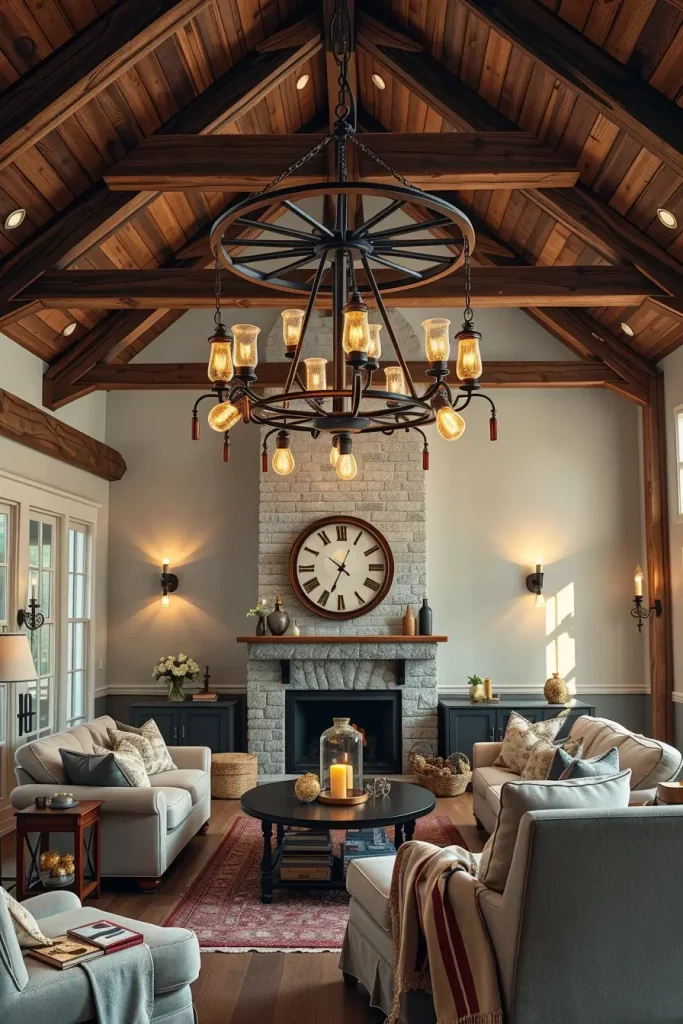
I personally love to combine oversized pendant lights over a kitchen island with smaller sconces in hallways. Farmhouse lighting is usually focused on the exposed bulbs and metal components, but still, it has a warm and soft light. Natural materials such as wood or hammered metal are used to design fixtures that do not look outdated.
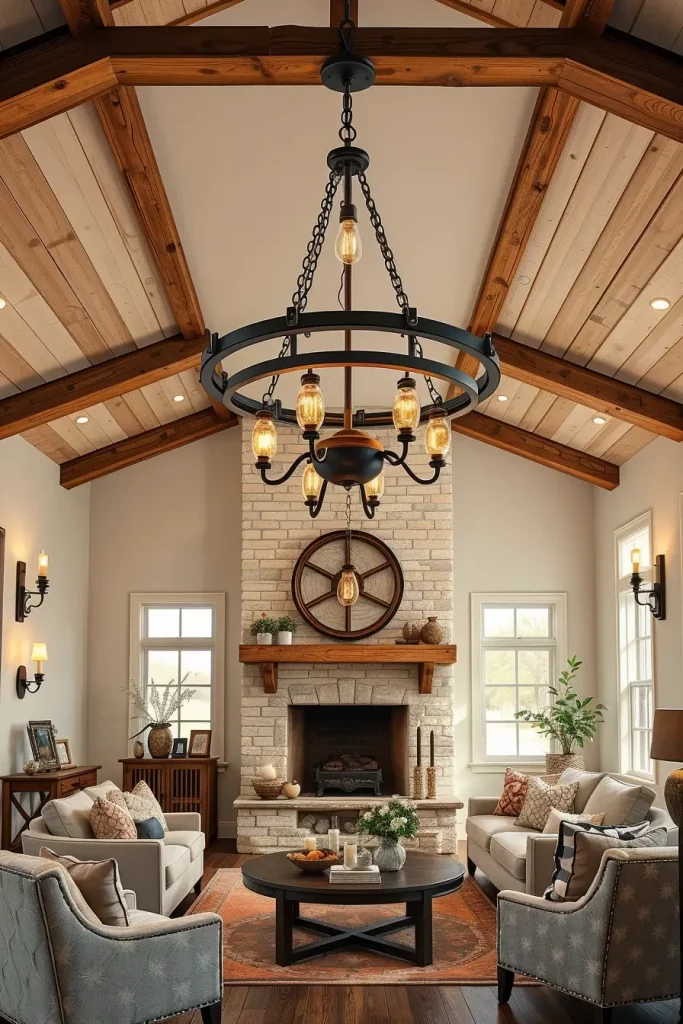
The lighting is where you can be daring in my experience. I once put a wagon-wheel chandelier in a client living room and it immediately became the focal point of the whole room. Architectural Digest suggests that the farmhouse lighting must be able to walk the line between rustic authenticity and modern functionality, so that spaces feel lived-in, yet contemporary.
The only thing I would add to this part is a recommendation on layering: the combination of overhead lights and task lamps or candle-like wall sconces allows making spaces versatile and usable on a daily basis.
Textiles And Fabrics For A Farmhouse Feel
I consider textiles as the heart of the farmhouse style. They make the rooms less woody and metallic, and they bring in a sense of comfort that makes the house homelike. Natural materials such as cotton, wool, and linen are paramount. Consider gingham curtains, plaid blankets, and handwoven rugs, all the staples of rustic farmhouse decor.

I prefer neutral fabrics like beige, cream, and gray with earthy green or muted blue highlights when I choose fabrics. A farmhouse living room, say, may have a huge slipcovered sofa with knitted throws and a variety of patterned cushions. Burlap table runners and linen drapes are other minor details that helps to reinforce the theme.
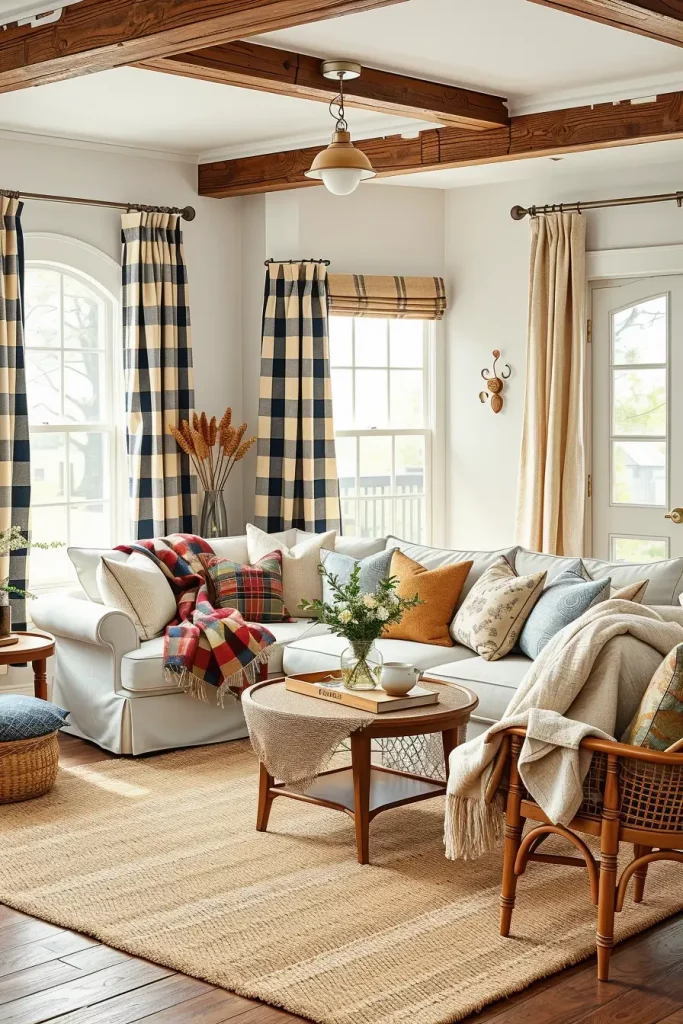
To my mind, it is in textiles where personal expression comes out most. To add depth without overpowering the room, I have discovered that it helps to layer several different textures together, like using a jute rug with some linen curtains. Well-known designers like Joanna Gaines frequently stress the importance of textiles to ground farmhouse design.
The thing I would add here is seasonal flexibility: changing pillow covers or throws with the seasons is a cheap and easy way to change the farmhouse look without having to buy new furniture.
Farmhouse Flooring Options With Character
Flooring in a farm house should be hard wearing but also attractive. I would suggest wide plank hardwood floors as they add a sense of warmth and authenticity to a room. Reclaimed wood with visible knots and grain will give each room a feeling of history, and stone or brick flooring is ideal in kitchens or mudrooms to add a touch of practicality.
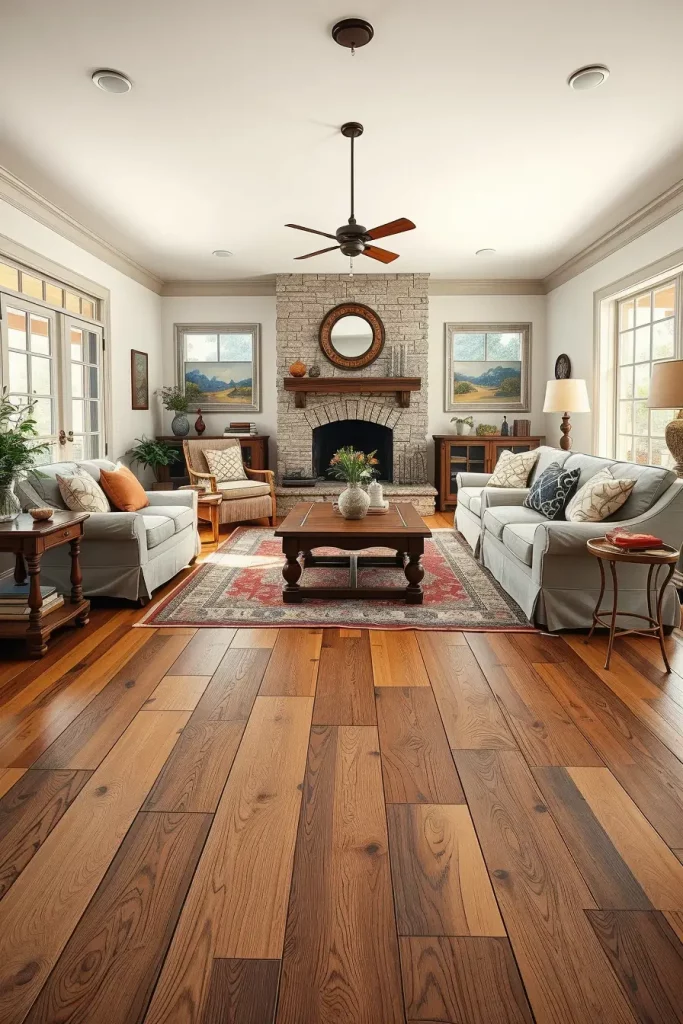
I tend to direct clients to lighter stains to create an open feel or darker, medium stains to create a cozy feel. The use of distressed finishes and matte textures help the area avoid the overly polished look, remaining in the farmhouse style. The flooring is complemented with a patterned rug placed on top, which adds comfort and ties the flooring into the overall décor.
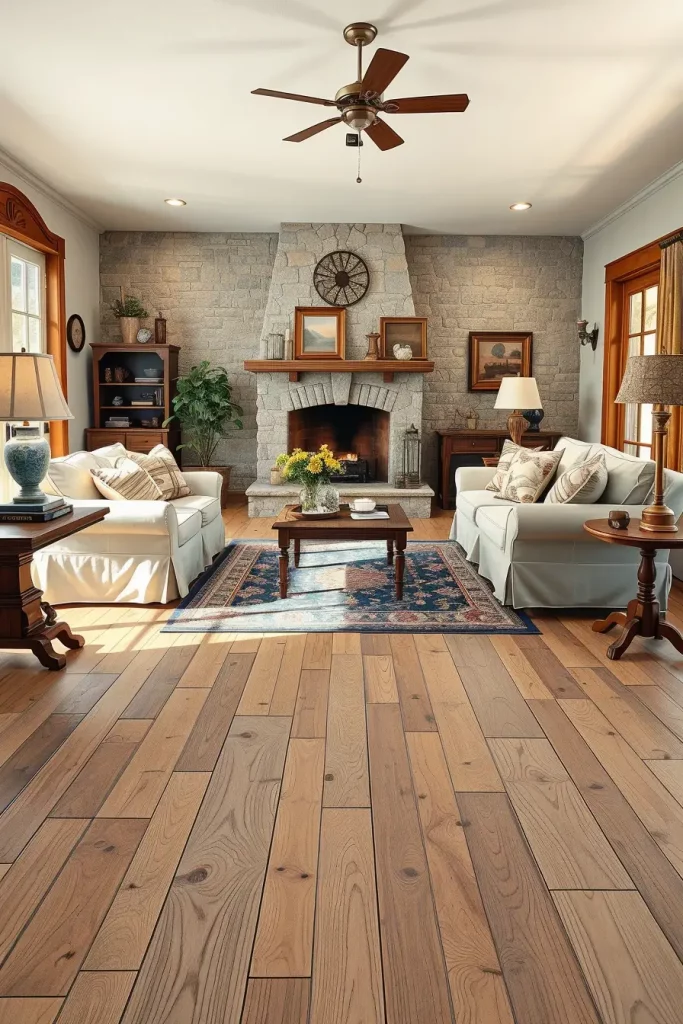
In my opinion, flooring is the basis of all design decisions. I have witnessed the change of homes with just the replacement of the dull tiles with natural wood or brick designs. Magazines such as Elle Decor tend to emphasize that farmhouse flooring must be practical and pardonable- perfect to have in a household with children or pets.
To make this section even more complete, I would add radiant heating systems under the flooring of a farmhouse style, as it will introduce modern comfort without sacrificing the looks.
Shiplap Walls And Rustic Wall Treatments
Shiplap walls are one of the most famous farmhouse interior features. I usually suggest them to clients who are in need of a balance between a clean line and rustic feel. White painted, they add light to a room, but they still add texture. Natural or stained, they underline the warmth of the wood.

Besides shiplap, I also make use of beadboard, stone cladding, or reclaimed wood panels to make feature walls. These rustic finishes provide depth and aesthetic appeal, and they can be used well in fireplace areas, dining rooms, or even in bedrooms as accent walls. They are paired with little decoration and shine by themselves.

Personally, I have found shiplap to be a classic investment. I have installed it in contemporary and more traditional homes and it fits perfectly. As experts such as Chip Gaines will tell you, shiplap makes a blank canvas, which makes other items such as furniture and artwork to shine.
I would also include textured paint or limewash finishes as an option to those who want the rustic look but not as an extreme as wood paneling.
Farmhouse-Inspired Windows And Curtains
Farmhouse design relies heavily on windows as they allow the outdoors and the indoors to interact. I always advise clients to make use of maximum natural light by using large, grid-style windows with black or wood frames. These add to the architectural appeal and highlight the rustic yet functional farmhouse style.
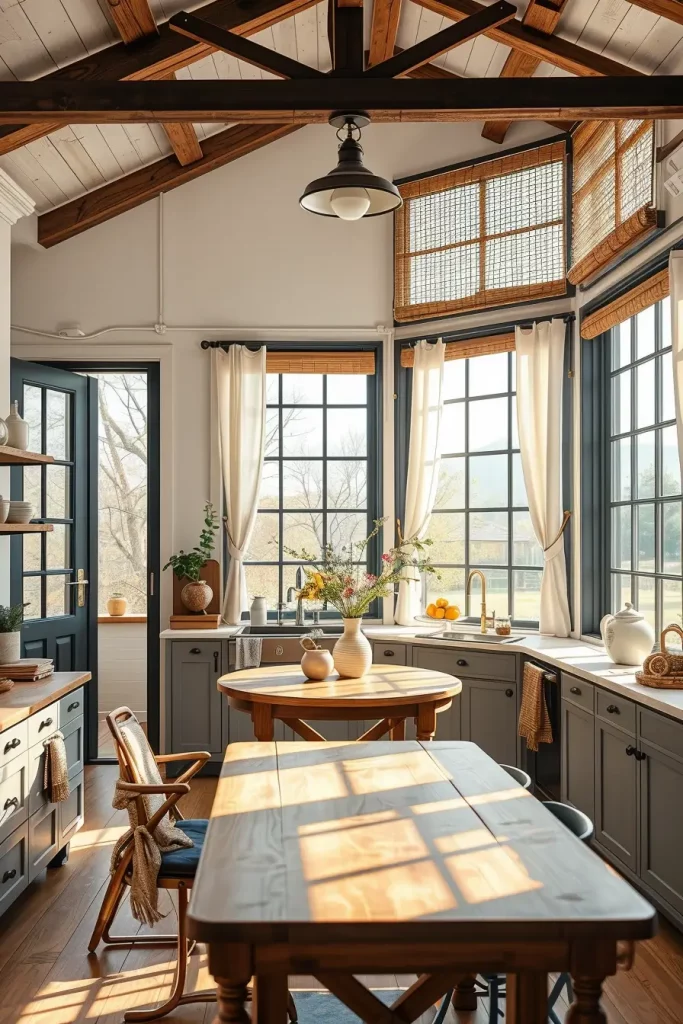
I like natural materials such as linen or cotton in light colours in the form of curtains. Cafe curtains also look fantastic in kitchens, and full length drapes in neutral, light colors make living rooms look better. Woven shades or shutters are also able to provide privacy and texture.

To my mind, farmhouse windows are supposed to frame the landscape outside as well as they lighten the interiors. I remember a farmhouse remodel where large windows that looked out to the fields were the center piece. Magazines such as Country Living will often emphasize how window treatments must be subtle and not take center stage over light and views.
What is usually lacking here is layering treatments-combining shades with sheer curtains not only serve a practical purpose but also adds style to the windows.
Rustic Farmhouse Outdoor Living Spaces
Farmhouse design really comes to life outdoors I usually design patios and backyards that are an extension of the interior, which include wood decking, natural stone paths, and durable outdoor furniture. There are String lights, lanterns, and fire pits that create a warm atmosphere and encourage people to stay out late.
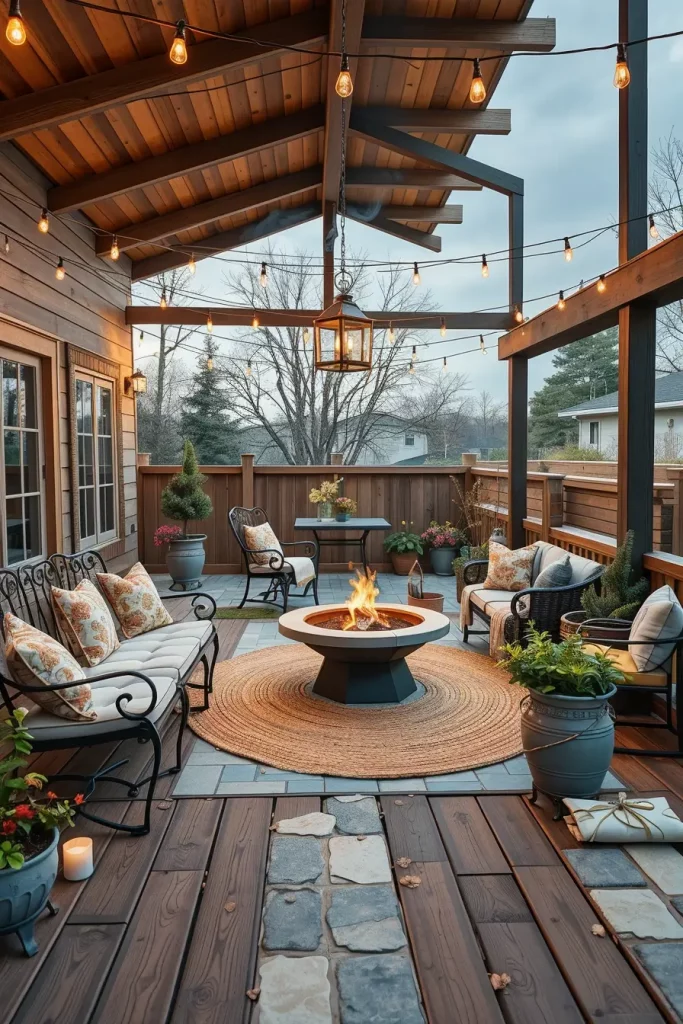
The outdoor furniture that I use tends to resemble the interior one: wooden dining tables, wrought-iron chairs and cushioned benches with water-resistant fabrics. Galvanized tubs to hold drinks, vintage planters and woven outdoor rugs add to the farmhouse feel.
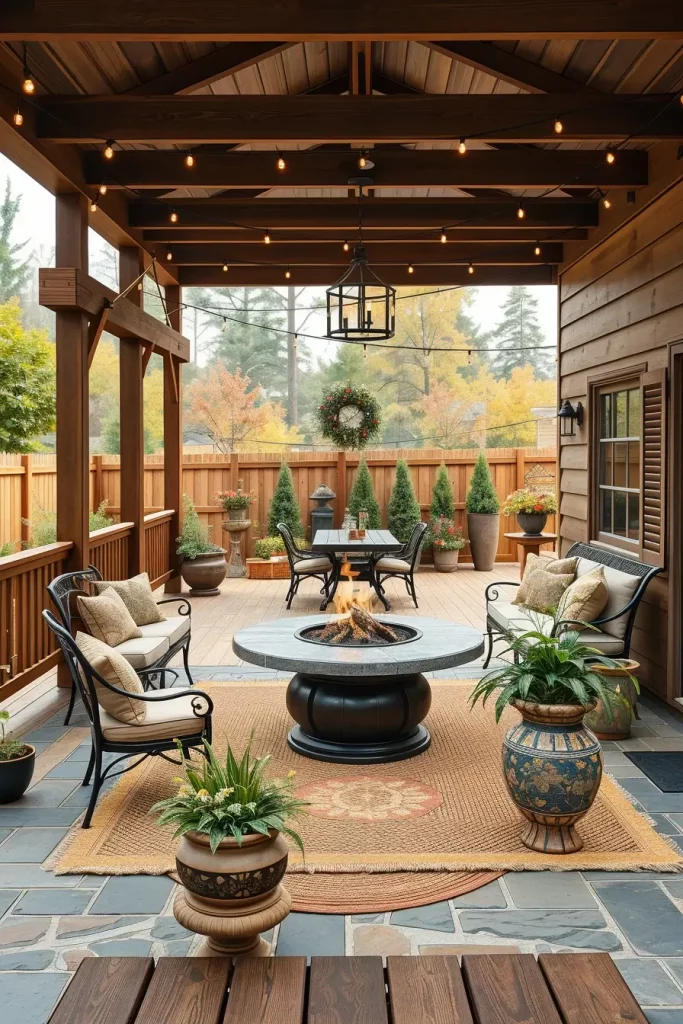
In my experience, outdoor spaces ought to be comfortable and connected. I have even designed porches that have swinging benches and piles of blankets, the ideal place to relax. Better Homes & Gardens suggests that farmhouse outdoor design should be both functional and comfortable, to be used throughout the year.
In this part, I would recommend edible gardens or raised planter boxes that not only contribute to sustainable living but also add a rustic touch with a traditional touch.
Farmhouse Porches And Patio Inspirations
A farmhouse porch or patio is not merely an outside extension, but the centre of hospitality out of doors. I always stress on comfort and timeless design in these areas and I urge homeowners to incorporate rustic charm with modern functionality. They are welcoming with wooden floors, wide porches and rocking chairs being traditional features. The overhead beams and the exposed rafters enhance the rustic farmhouse style.

As far as furniture goes, I usually pick wicker or wooden rocking chairs, a porch swing with cushions, and a sturdy farmhouse table to gather around. The accessories such as lanterns, string lights, and potted plants add a touch of class and give a welcoming impression. A painted front door, usually in a darker color such as sage green or deep blue, is a character feature that balances with the natural environment.
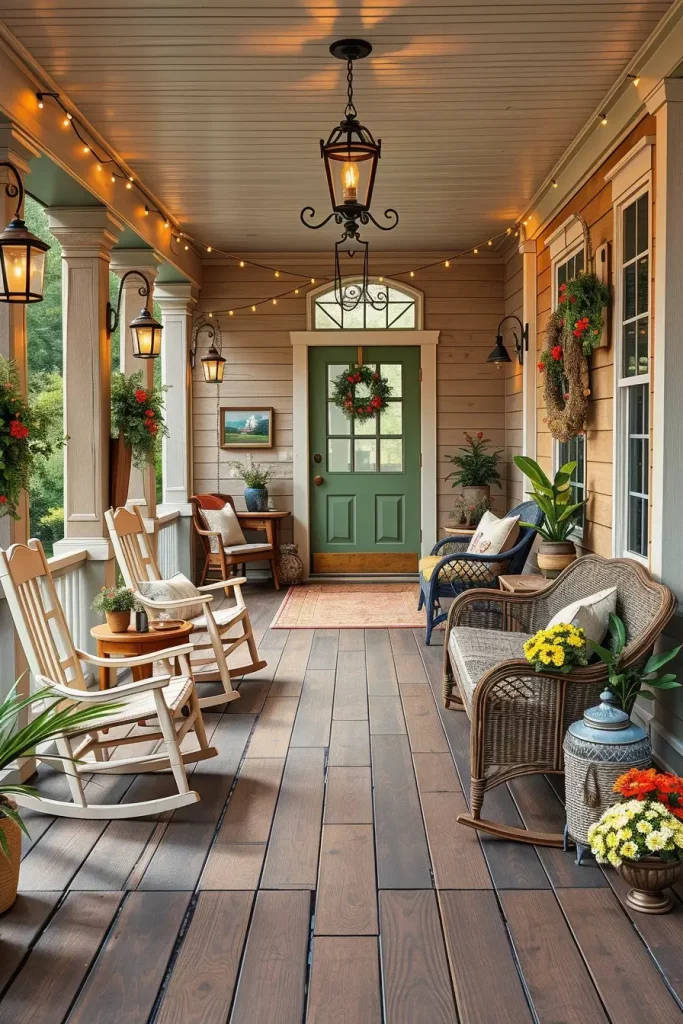
In my personal projects, porches are places of gathering. I once did a wraparound porch with a big dining table so that the family could hold dinner parties outside. Better Homes & Gardens experts often suggest combining furniture that is durable and resistant to weather conditions with soft materials, which creates the balance of comfort and functionality.
To fill this section, I would have layering outdoor rugs and seasonal wreaths on doors. Such minor details relate the porch to the general design of the farmhouse making it stylish and personal.
Barn Doors And Sliding Door Details
Barn doors are the staples of rustic farmhouse decor, and I believe they are one of the most universal design elements. Not only do they save space but also are used as eye-catching architectural details. Barn doors can be left in a natural wood finish or painted in neutral colors, which is why they can instantly add rustic flair to any room as well as remain highly functional.

I normally suggest using solid wood barn doors with black iron hardware. Clients like having a double sliding door on larger openings, and some clients like having a single door in hallways or bedrooms. They can be made more appealing by using frosted glass inserts or cross-bracing details to make them more practical.

Personally, I have witnessed barn doors turn ordinary rooms into standout rooms. A project I did was replacing a typical bedroom door with a reclaimed wood sliding barn door and it became the most photographed item in the home. Designers such as Joanna Gaines tend to emphasize barn doors as a combination of the past and functionality.
I would also include customization here: putting in barn doors with inbuilt shelving or chalkboard surfaces is both creative and storage. This contemporary twist does not make the design lose its farmhouse authenticity but makes it feel current and modern.
Rustic Farmhouse Fireplace And Mantel Designs
A rustic farmhouse fireplace is not just a place to get warm, but the center of the living room. I frequently create fireplaces with natural stone or reclaimed wood mantel, which is the focal point of the whole house. This accent point emits warmth and adds the farmhouse look with a vintage appeal.

I would use chunky reclaimed beams or distressed wood shelves as mantels. Dressing them with lanterns, old clocks, piled books and framed family photos make the display personal and warm. A stone or brick surround of the fireplace further adds to the rustic effect.
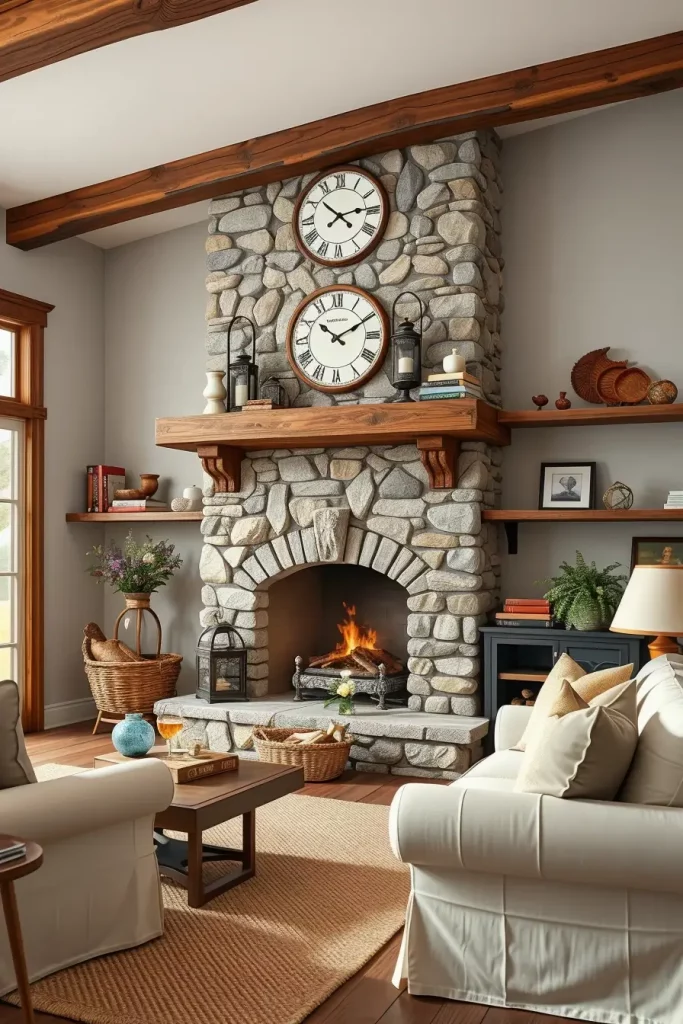
I have found that fireplaces ground a room. I remember creating one with a limestone hearth and a thick wooden mantel and it instantly attracted people. Magazines such as Country Living often show how farmhouse fireplaces can combine rustic materials with a clean, modern design.
To add a little extra, I would recommend built-in cabinets around the fireplace. This not only improves storage but also gives a smooth farmhouse look with a polished finish.
Farmhouse-Inspired Storage And Shelving Ideas
Storage is an important element in ensuring that the farmhouse aesthetic is not compromised. I love open shelving made of reclaimed wood, which is combined with wrought-iron brackets, which is beautiful and practical in kitchens and living rooms. It can transform ordinary objects into decoration and keep space neat.

I also frequently employ freestanding cabinets, with distressed finishes, woven baskets, and storage benches. Floating shelves above desks or entryways are excellent to use to show off decorative pieces such as mason jars, ceramic pitchers, or vintage books. Every element is functional but fashionable.

As far as I am concerned, farmhouse storage solutions promote simplicity and creativity. I have actually installed open shelves in a farmhouse kitchen, and it made cooking much more pleasant because everything was at hand, and yet it looked curated. House Beautiful suggests that farmhouse shelving must be a combination of both beauty and functionality, so that the rooms look natural and lived-in.
The concept I would bring in here is the idea of concealed storage in unexpected locations- like under window seats or behind sliding barn doors- to make the most of the space without sacrificing the rustic aesthetic.
Decorative Accents That Define The Farmhouse Look
As far as decorative accents are concerned, small details are the most important to achieve the farmhouse spirit. I never fail to advise clients to combine vintage and modern accessories to bring out equilibrium. Pieces such as mason jars, galvanized trays, and ceramic pitchers are more authentic, and woven baskets and wooden trays are more warming.
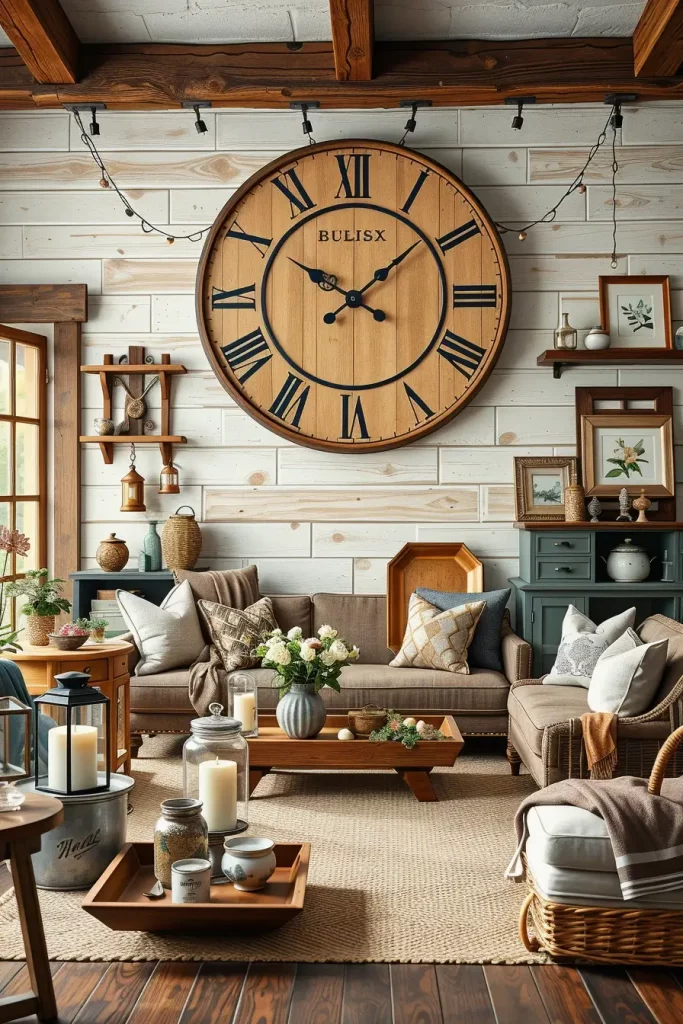
I tend to use wall clocks with large faces, distressed picture frames and candle lanterns. In eating places, enamelware and vintage dishware can be used as decor. All accents must be connected to the natural textures and dull color schemes, so that the space is harmonious.
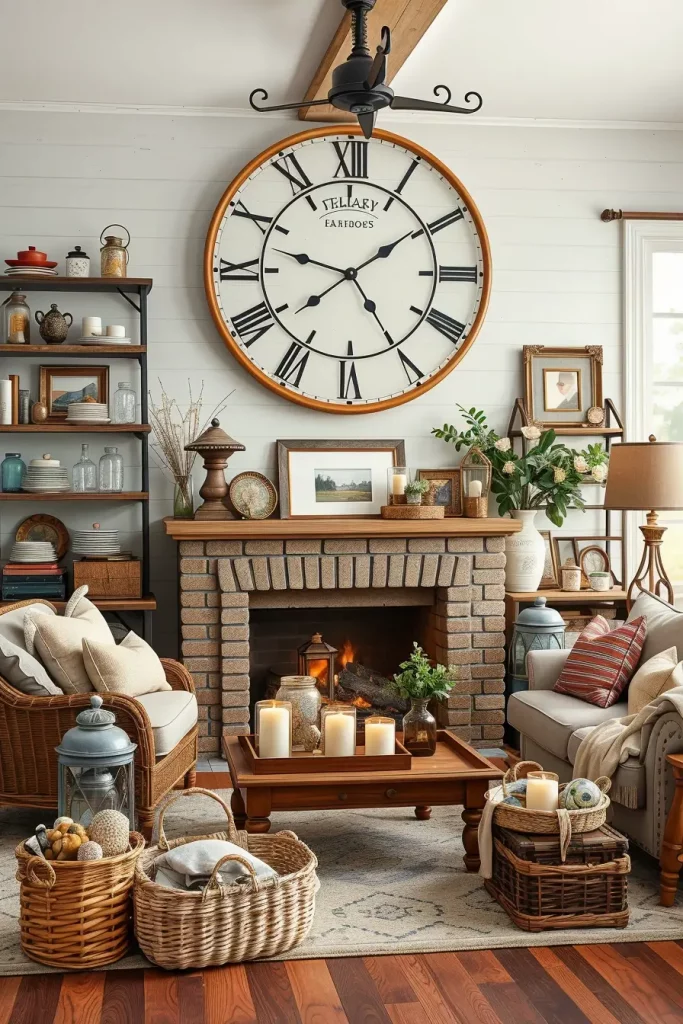
I have discovered that accents can be layered to give richness in my personal projects. One client had a set of vintage tools displayed above their dining table and it was a statement piece that was not soon forgotten. Elle Decor says the key to farmhouse design is the ability to tell a story through the accents.
To further improve this area, I would suggest changing the seasonal decorations like garlands or flowers to make the decoration fresh and in sync with the changes of nature.
Rustic Farmhouse Artwork And Wall Decor
Farmhouse interiors are not flashy in artwork. I would recommend big farmhouse signs, retro-style prints, or naturalistic paintings. Handcrafted items, particularly those depicting natural landscapes, barns, or botanical drawings are a perfect fit to the rustic theme.

I usually recommend combining framed prints with three-dimensional items such as woven baskets or wooden plaques when choosing wall decor. A family photo gallery can be a rustic wall that has a personal touch to it.
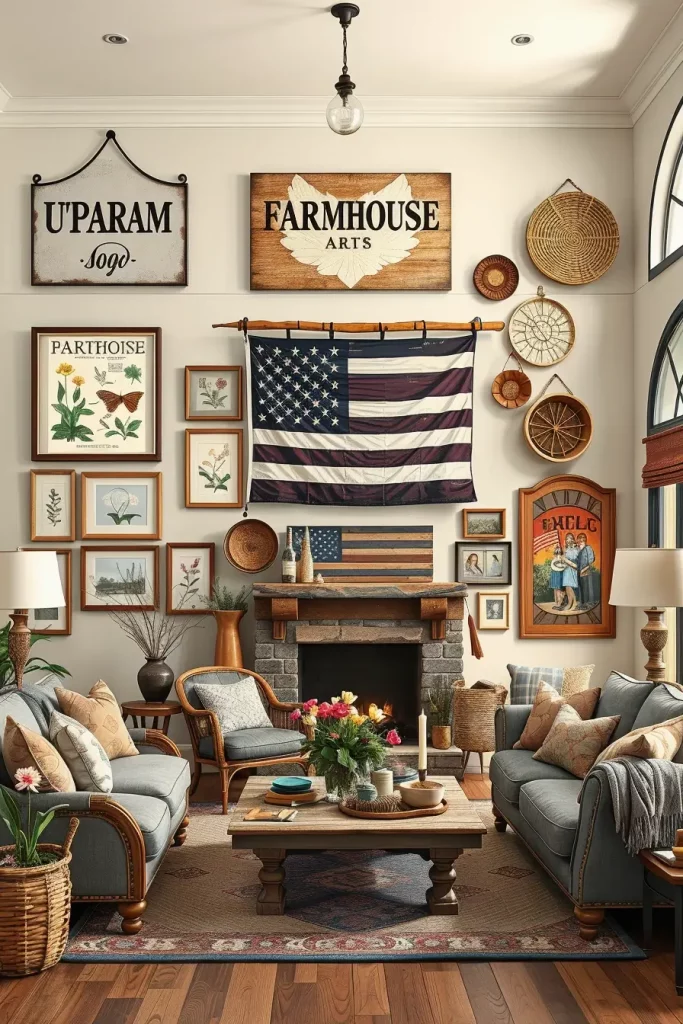
My personal experience with clients has shown that they like art that conveys a narrative. As an example, one client mounted a reclaimed wooden American flag in their living room and it became the emotional focal point. Magazines such as Architectural Digest tend to emphasize how farmhouse art must be a combination of personal history and rustic sophistication.
To finish this section, I would add farmhouse mirrors that are framed in distressed wood. Mirrors do not only reflect light but also offset the heavy textures that are usually present in farmhouse interiors.
Seasonal Decor For A Rustic Farmhouse Home
The farmhouse style is one of the most pleasant things about seasonal decor. I enjoy changing with each season with small but important accents. In autumn, pumpkins, plaid blankets, and warm-colored wreaths are the rule, whereas in winter, evergreens, candles, and rustic garlands are the order of the day. Spring brings in florals, summer brings in light linens and fresh greenery.

I typically suggest putting away reusable seasonal decor such as wreaths, lanterns, and fabric garlands. Changing pillow covers, table runners, or wall art to reflect the season without breaking the bank keeps spaces fresh without breaking the bank.
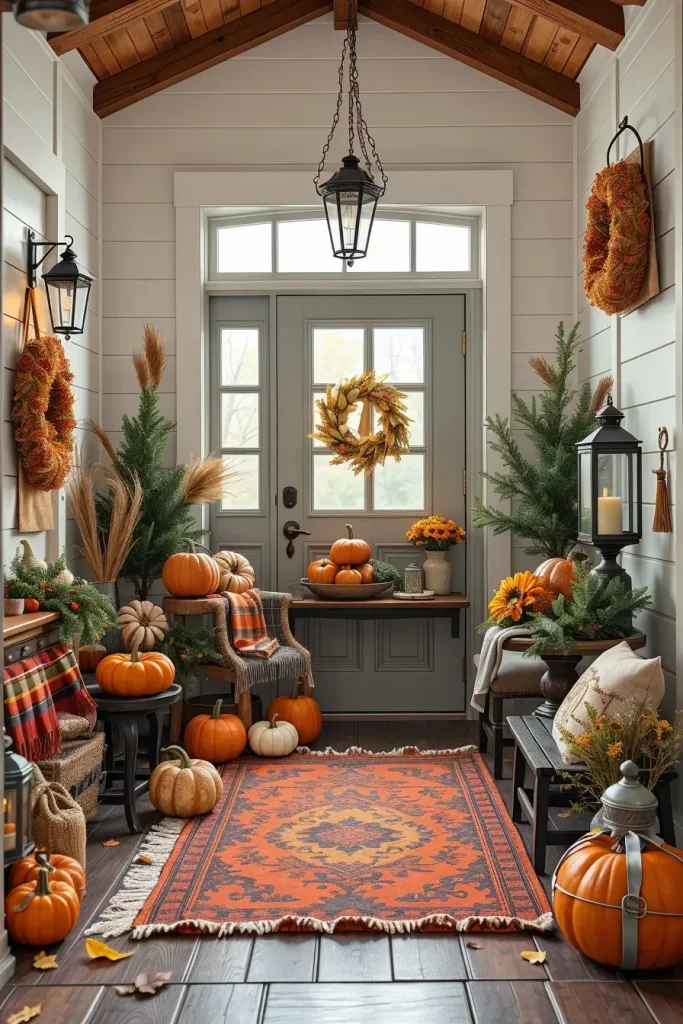
I am a fan of how seasonal decorations can change the look of a place without much effort. A farmhouse home that I worked on last year changed its entryway with each season, and it was a neighborhood favorite. Better Homes & Gardens frequently mentions how seasonal changes can make a home more in touch with nature.
To make this section even more interesting, I would recommend purchasing quality storage of the seasonal items, so that each item can last several years and still have its rustic appearance.
Modern Twists On Rustic Farmhouse Aesthetic
I like to incorporate modern elements when I create a space around the rustic farmhouse look so that the home feels more current. Neutral color schemes such as soft whites, grays, and earth tones are a perfect match with natural wood beams and stone textures. I believe that the layering of modern lighting fixtures or smooth hardware on cabinets helps to offset the rustic appeal with the functionality of the modern world. This is aimed at achieving a mix- one that does not disregard the old but embraces the new.

I always incorporate staple items like reclaimed wood dining tables, linen upholstered chairs, and a farmhouse sink in the kitchen. However, I would also consider adding industrial-style pendant lights, minimalist shelving, or a marble countertop to bring a sense of sophistication. This combination brings the rustic style to a new level of being new and modern in terms of interior design.
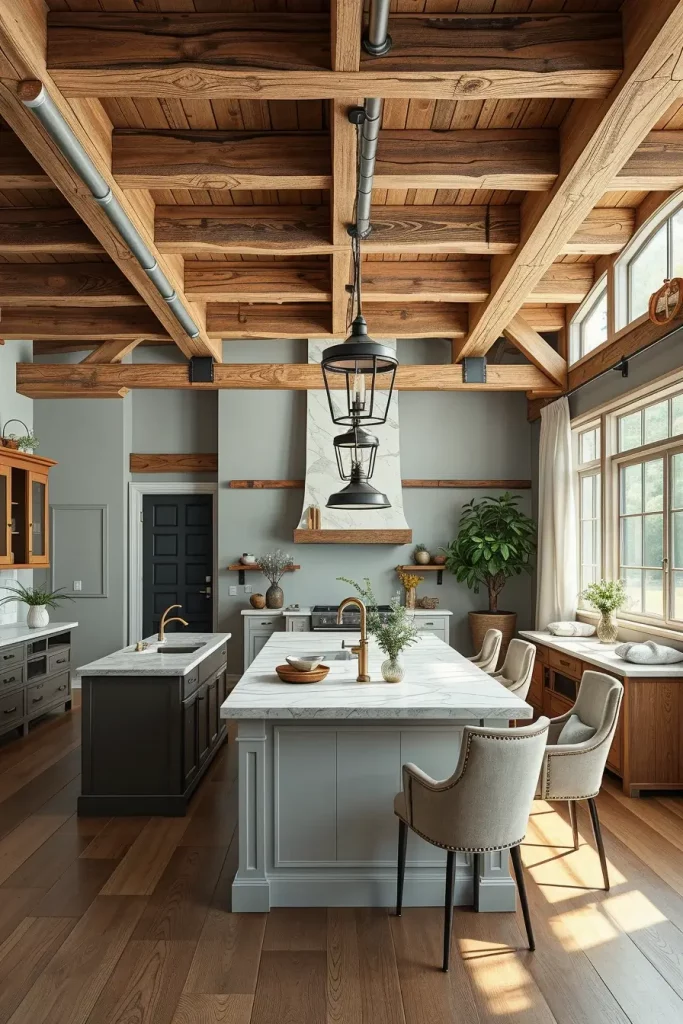
As I have learned, design gurus like Joanna Gaines have repeatedly noted that restraint is what makes the balance between rustic and modern. In her Magnolia Journal, she advises against filling a room with too many farmhouse details but instead letting a few signature pieces be the focal point. I could not agree more, I have learned that sometimes less can be more when updating this aesthetic.
To improve this area, I would suggest using plants in the form of pots or eucalyptus display. They bring freshness and they add to the rustic warmth of the space.
Rustic Farmhouse Design For Small Spaces
Decorating with rustic farmhouse style in small areas is a challenge that needs creativity and smart furniture selection. In my work, I focus on the maximization of natural light, lighter walls, and multi-purpose pieces. These solutions make the space open and light and at the same time retain the warm feeling of a farmhouse.

As an example, I prefer to use foldable farmhouse tables, benches with concealed storage, and slender shelving units manufactured out of reclaimed wood. In a small kitchen, a farmhouse sink may be installed without giving up excessively much counter space, and barn-style sliding doors take up less space than swinging doors.
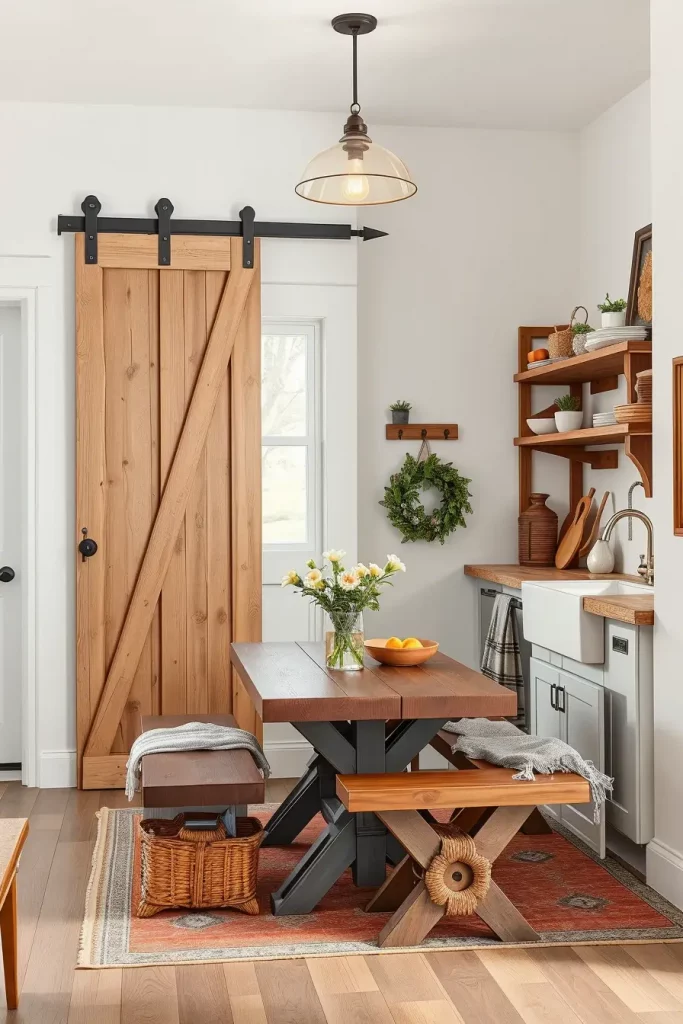
Smaller rooms should have furniture that is well scaled as seen in expert advice by Better Homes & Gardens. Large rustic furniture can be too much in the space so I suggest going with slightly smaller but still rustic pieces like a small wooden console table or skinny ladder shelves. I have used this personally in apartments, and it really makes cramped spaces feel like a home.
I would also recommend including some warm textiles like throw blankets or natural fiber rugs to make this section more complete. These details create a small farmhouse-style house that is layered and welcoming without occupying more space.
Budget-Friendly Rustic Farmhouse Decorating Ideas
Not all of us can afford to turn our house into the rustic farmhouse look, but I think that this style is ideal to work with a limited budget. As it embraces recycled materials, second-hand items, and do-it-yourself accents, it is not very expensive to create this style. I always recommend to the clients to begin with what they already have and reuse it into farmhouse decor.

Cheap objects such as mason jar lighting, thrifted wooden chairs, or second-hand chests can be sanded, repainted and re-purposed. I have discovered that open shelving using simple brackets and reclaimed wood planks is not only cost effective, but also very practical in kitchens and living rooms. The addition of distressed picture frames, galvanized metal baskets, or simple cotton curtains can also do a lot without straining the budget either.
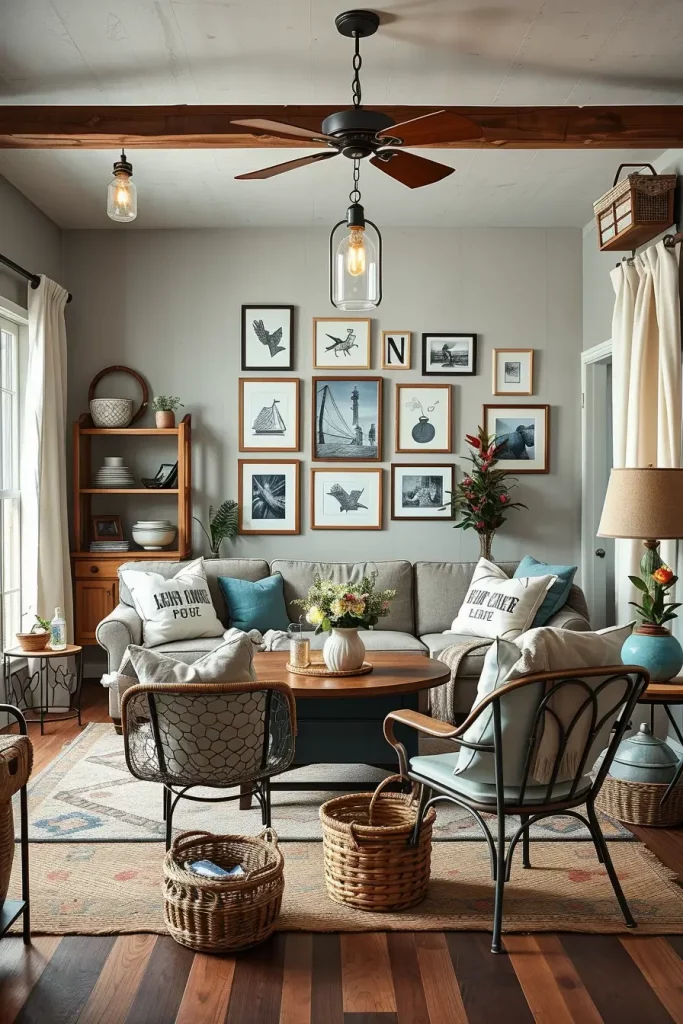
My own advice is to go to local flea markets and antique stores. In the U.S., designers of Country Living magazine are fond of emphasizing that farmhouse style is about imperfection: faded wood, chipped paint, handwoven textiles all have a story to tell. I have gotten some of my best rustic items this way and they immediately give a home authenticity.
To add even more value to this section, I would recommend to add DIY wall decoration tips, like how to make a gallery wall with old signs or botanical prints. It is inexpensive and very customizable.
Embracing The Timeless Farmhouse Aesthetic
The rustic farmhouse style has continued to be an inspiration to homeowners due to its combination of warmth, functionality, and timelessness. This style can be modernized, scaled down to fit small areas, or done on a budget and still fit right into the modern home. I think its timeless appeal is that it feels lived in, comfortable and personal.

When considering how to implement this style in your personal residence, it is important to keep in mind that it does not need to be flawless. It is the little flaws- the frayed edges, the contrasting textures, and the handmade objects that make the farmhouse style so welcoming.
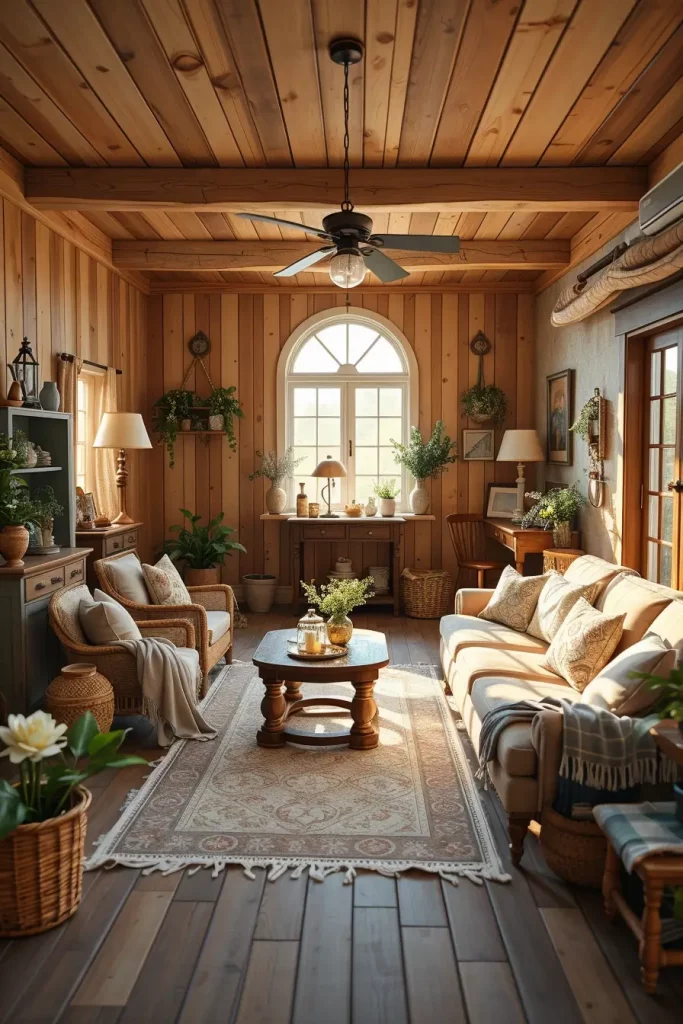
What rural farmhouse features would you incorporate in your house? Share your ideas and experiences in the comments below, I would love to hear your opinion on this classic design.
The rustic farmhouse style is a perfect combination of warmth, comfort, and timeless style. This style achieves a balance between natural materials, vintage appeal, and functional furniture to create an atmosphere that is both welcoming and real. Whether you are redesigning one room or the whole house, farmhouse style gives you a limitless choice of mixing the past with present-day living. Which are your favorite farmhouse design ideas? Share your thoughts in the comments below!
